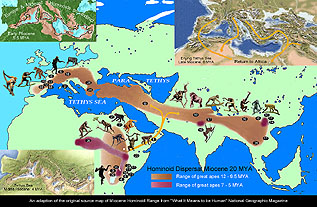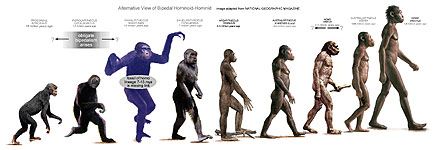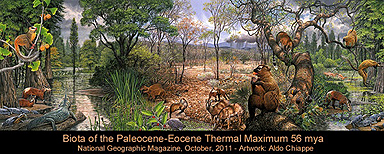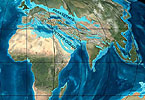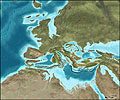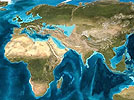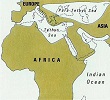Note: My Anthropic Trilogy WebBook, evolving since 1997, is a chronicle of my passing all considered opinion through the lens of my Nirvikalpa Samadhi with both an open-mind and healthy skepticism.
An Exploration of Our Hominoid - Hominid Evolution
It is no surprise that the credibility of interpretations attempting to explain, reconstruct and position any organism in a Tree of Life - despite applying every advanced paleontological method available - diminishes exponentially the further back in time we go. In the quest for our human story, the challenge rises immediately in the last 14-10 Ka for a reliable scenario for the peopling of the Americas and gets increasingly complicated and more speculative as evidence of slow climatic and geophysical changes must be factored in to correlate with relatively swift biogenetic evolution. Advances in molecular genetic science has improved our understanding of the past 50 K of our Homo sapiens prehistory but our phylogeny becomes fraught with uncertainty as to exactly what fossil represents a direct ancestor. Credible candidates include H. heidelbergensis and H. antecessor from 1.3 Ma but of the half dozen or so Homo species preceding these - until Homo habilis from 2.8 Ma - no prior transitional species has been identified. Compared to the ancestral lineage for Homo erectus that includes H. rudolfensis and H. ergaster, the pages in the story of that million-year-chapter of our Pleistocene phylogeny are missing.
Back in the Pleistocene (5.3-2.6 Ma) our hominin evolution is well underway but scant fossil evidence is subjected to homology and analogy and a range of theoretical, heuristic and Bayesian interpretation, so facts are expressed in consensus phylogeny and whole colleges of contradiction emerge.
 Further on - the Miocene (23-5.3 Ma) a most dynamic epoch both in terms of geological and climatic transformation and that of the scale and scope of our hominoid evolution and dispersal. Aside the range of geophysical interpretation as to how and when Africa connected to Eurasia and how the Tethys Sea was configured - major phylogenetic amd biogeographic contention has arisen such as the controversy over whether the transformation from hominoid to hominid in our ancestral homo lineage occurred in Europe or Africa. The nature of good science is robust debate and paleo sciences not only produces greater quantity but a more extensive range of topics that engage not only paleoanthropology and a host of other science disciplines like phylogenetics, paleogeophysics, paleoclimatology
but extends into the humanities and even the transpersonal as it searches and interprets evidence to refine the story of our human and cosmic evolution.
Further on - the Miocene (23-5.3 Ma) a most dynamic epoch both in terms of geological and climatic transformation and that of the scale and scope of our hominoid evolution and dispersal. Aside the range of geophysical interpretation as to how and when Africa connected to Eurasia and how the Tethys Sea was configured - major phylogenetic amd biogeographic contention has arisen such as the controversy over whether the transformation from hominoid to hominid in our ancestral homo lineage occurred in Europe or Africa. The nature of good science is robust debate and paleo sciences not only produces greater quantity but a more extensive range of topics that engage not only paleoanthropology and a host of other science disciplines like phylogenetics, paleogeophysics, paleoclimatology
but extends into the humanities and even the transpersonal as it searches and interprets evidence to refine the story of our human and cosmic evolution.
A contemporary example of competing theories about the origin of our Hominoid ancestors is the ongoing debate between equally qualified paleontologists. David R. Begun is professor of anthropology at the University of Toronto and follows evidence that our most immediate hominoid ancestors evolved in Europe from more primitive migrants out of Africa millions of years earlier that returned to Africa in the late Miocene to further evolve into hominids. His 2015 book The Real Planet of the Apes presents his scientific work on Miocene Apes to a popular readership.
On the other hand in Origins of the African hominoids: an assessment of the palaeobiogeographical evidence Susanne M. Cote, Phd. Department of Anthropology, Harvard University argues that the abundance of fossil ape remains in Eurasia, compared with a dearth of similar-aged apes in Africa is due to sampling: Eurasian localities are much richer and more diverse during this interval than African localities, and hence their apes are better represented. Africa has yielded the oldest and most diverse Miocene/Pliocene hominoids. It is the only continent where the chimp and gorilla live in the wild, and it has the earliest bona fide hominid sensu stricto remains. Moreover, there is no evidence of a mass ape extinction (in Africa) at the end of the Middle Miocene, nor is it likely that a Eurasian species founded the African ape/human clade as the result of a biogeographic retreat from Eurasia.
New Apes Fill the Gap by Raymond L. Bernor. The relative abundance of Eurasian apes between 12.5 and 8 Ma, in contrast to a dearth of African apes during the same chronologic interval, has led some investigators to suggest that the African ape—human clade evolved from a Eurasian ancestor, specifically, a previously undescribed and unnamed ape from Turkey. In the last several weeks, three new ape genera have been reported, one from Turkey (Ouranopithecus turkae), one from Ethiopia (Chororapithecus abyssinicus), and the latest, Nakalipithecus nakayamai, from Kenya, (the size of a female gorilla, dating 9.9-9.8 Ma). The apparent 14-7 Ma African "ape gap" is now populated not only by Nakalipithecus but also by the penecontemporaneous Kenyan large ape Samburupithecus kiptalami, dated slightly younger at 9.6 Ma, and by yet another large gorilla-like ape, C. abyssinicus, from the 10.5-10 Ma horizons of Chorora, Ethiopia. Additional isolated, but important, large ape remains from Ngorora, Kenya, localities believed to be ~12.5 Ma may evidence even greater species diversity. Did the African ape-human clade arise in Africa, after all? Some think so. Where there was once a wide gap, we are now provided with a substantial intra-African great ape diversity in the 12.5-9.6 Ma interval. See also: Dispersal of Hominines Into Africa in the Late Miocene
An example of a popular approach to consensus phylogeny on the same topic: Did Africa's Apes Come From Europe? Smithsonian Magazine.
The following is an entertaining example of how contentious controversies can become among the academia of paleontology. Review of Hominid Adaptations and Extinctions a book by David W. Cameron, Ph.D. at Australian National University. A review by Monte L. McCrossin, Department of Sociology and Anthropology, New Mexico State University, Las Cruces, NM. that leaves out any academic nicities. "From the outset, it bears mentioning that Cameron's use of the word hominid refers not only to humans and their ancestors but to great apes and their progenitors as well. This book is really about Miocene hominoids. In a perversion of paleoanthropological history that is so fraught with irony that it borders on the surreal, Cameron credits David Pilbeam for our current understanding of divergence dates within the Hominoidea, including the realization that "the emergence of the earliest proto-humans from their proto-chimp cousins was proposed to be as late as 6 to 5 million years ago". By far the most misleading and inaccurate sections of this book pertain to the pivotal middle Miocene hominoids of Africa, especially Kenyapithecus. It does not help that these sections are also plagued by some of the worst writing in the book."
So in the spirit of exploration, the following material is presented to help in forming a plausible scenario regarding phylogenics and dispersal during one of the most dynamic, long-lasting and far-ranging episodes in our species recent Paleozoic evolutionary history — Hominoid Radiation in the Miocene epoch (23-5.4 Ma).
An Interactive Image Map of Hominoid Radiation
in the Miocene Epoch
Click on image for full-scale interactive map.
About Reconstruction and Artistic Rendering of
Paleohominoid Illustrations
The quality of fossil evidence that is used to, interpret and identify the various Miocene hominoid genus and species and describe their morphology, behavior and ecology understandably is better for the more recent than for those millions of years back in the Early Epoch. Except for exceptional troves of almost complete skeletal remains like those of Oreopithecus in Sardinia or the fossil hand bones of Hispanopithecus in Spain - even the best of the Late Miocene fossils is limited to cranial remains and fragments of extra-cranial bones like femors and ulnas, etc. Early Miocene species are described almost exclusively from teeth assemblages and for some genus or species - from a single tooth. So reconstructions and renderings of the various ape figurines in these pages embody a fair share of artistic license and imagination that often result in markedly different character of the same animal as in the examples contrasted below.

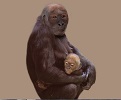
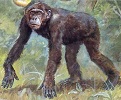

Miocene Hominoids
Some Paleontology Definitions:
Paleontology Paleontology or palaeontology is the scientific study of life existent prior to, and sometimes including, the start of the Holocene Epoch roughly 11,700 years before present through the examination of fossils. This includes the study of body fossils, tracks (ichnites), burrows, cast-off parts, fossilised faeces (coprolites), palynomorphs and chemical residues. Modern paleontology sets ancient life in its context by studying how long-term physical changes of global geography paleogeography and climate paleoclimate have affected the evolution of life, how ecosystems have responded to these changes and have adapted the planetary environment in turn and how these mutual responses have affected today's patterns of biodiversity. Hence, paleontology overlaps with geology (the study of rocks and rock formations) as well as with botany, biology, zoology and ecology — fields concerned with life forms and how they interact. Paleoanthropology specialise in vertebrate paleontology, dealing with fossils of animals with backbones, including fossil hominids.
Paleoanthropology Biological anthropology, also known as physical anthropology, is a scientific discipline concerned with the biological and behavioral aspects of human beings, their related non-human primates and their extinct hominin ancestors. It is a subfield of anthropology that provides a biological perspective to the systematic study of human beings. As a subfield of anthropology, biological anthropology itself is further divided into several branches. All branches are united in their common application of evolutionary theory to understanding human morphology and behavior.
Miocene The Miocene is the first geological epoch of the Neogene Period and extends from about 23.03 to 5.332 million years ago. The Miocene follows the Oligocene Epoch and is followed by the Pliocene Epoch. The apes arose and diversified during the Miocene, becoming widespread in the Old World. By the end of this epoch, the ancestors of humans had split away from the ancestors of the chimpanzees to follow their own evolutionary path. The Miocene is of particular interest to geologists and palaeoclimatologists as major phases of the Himalayan orogeny had occurred during this time. The Tethys Seaway continued to shrink and then disappeared as Africa collided with Eurasia in the Turkish—Arabian region between 19 and 12 Ma. The subsequent uplift of mountains in the western Mediterranean region and a global fall in sea levels combined to cause a temporary drying up of the Mediterranean Sea (known as the Messinian salinity crisis) near the end of the Miocene. See also: Age of the ArabiaEurasia Collision
Extinct Hominoidea General Introduction: Hominoid/Apes first appeared in Africa during the Early Miocene Epoch 23-16 Ma (million years ago). The regions of Egypt, Ethiopia, Kenya, Uganda, and Nambia are littered with the earliest of their remains however homonoid fossils in Africa of a size commensurate with a lineage to Australopithecine, from the period 13 Ma to 7 Ma - are virtually absent. The Miocene is called the "The Golden Age of the Apes" as by the time it ended 5 Ma, perhaps hundreds of species had evolved, radiated and/or become extinct throughout their range in Africa and Eurasia.
Extant Hominoidea are a branch of Old World tailless anthropoid catarrhine primates native to Africa and Southeast Asia. There are two extant branches of the superfamily Hominoidea: the gibbons, or lesser apes; and the hominids, or great apes.
The family Hylobatidae, the lesser apes, include four genera and a total of sixteen species of gibbon, all native to Asia. They are highly arboreal and bipedal on the ground.
The family Hominidae, known collectively as the great apes, include orangutans, gorillas, chimpanzees, and humans; alternatively, this family clade is also known as the hominids. There are seven extant species of great apes: two in the orangutans (genus Pongo), two in the gorillas (genus Gorilla), two in the chimpanzees (genus Pan), and a
single extant species, Homo sapiens, of modern humans (genus Homo).
An Index of Some Miocene Hominoid Species
 1. Aegyptopithecus zeuxis Early Oligocene 35-33 Ma Egypt - An early fossil anthropoid that predates the divergence between hominoids (apes and humans) and cercopithecids (Old World monkeys). About the same size as a modern howler monkey.
1. Aegyptopithecus zeuxis Early Oligocene 35-33 Ma Egypt - An early fossil anthropoid that predates the divergence between hominoids (apes and humans) and cercopithecids (Old World monkeys). About the same size as a modern howler monkey.
 2. Proconsul Early Miocene 20-18.5 Ma Kenya & Uganda - There were a number of species of Proconsul: P. africanus was baboon sized, P. major was largest species and was gorilla sized, and P. hamiltoni which is tentatively dated at 24-27 million years which would make it the oldest ape (Walker, 1983; Caroll, 1988; Andrews, 1992). (Body sizes ranged from that of a small monkey (10 pounds) to that of a female gorilla (150 pounds).
2. Proconsul Early Miocene 20-18.5 Ma Kenya & Uganda - There were a number of species of Proconsul: P. africanus was baboon sized, P. major was largest species and was gorilla sized, and P. hamiltoni which is tentatively dated at 24-27 million years which would make it the oldest ape (Walker, 1983; Caroll, 1988; Andrews, 1992). (Body sizes ranged from that of a small monkey (10 pounds) to that of a female gorilla (150 pounds).
3. Ugandapithecus major Early Miocene 20 Ma Uganda - Lived around the site of a now-extinct volcano in Uganda's remote north-east Karamoja region. We can conclude that Ugandapithecus established a line of great apes other than Proconsul.
4. Afropithecus turkanensis Early Miocene 18-17 Ma Kenya - It is unclear at present whether life-history prolongation in apes represents the primitive catarrhine pace of life history extended through phyletic increase in body mass, or whether it is derived with respect to a primitive, size-adjusted life history that was broadly intermediate between those of extant hominoids and cercopithecoids. (Heizmann and Begun 2001: with its massive jaws and jaw musculature, Afropithecus may have been broadly ancestral to the Middle Miocene apes that expanded into Europe by about 17 Ma).
5. Engelswies hominoid Early Miocene 17.1 Ma Germany, in a fertile valley in what is now south-western Germany, north of the Alps - Updated chronology for the Miocene hominoid radiation in Western Eurasia Isaac Casanovas-Vilara,1, et al, 2011. Our results show that de tifiable Eurasian kenyapithecins (Griphopithecus and Kenyapithecus) are much younger than previously thought (ca. 14 Ma instead of 16 Ma), which casts serious doubts on the attribution of the hominoid tooth from Engelswies (16.3-16.5 Ma) to cf. Griphopithecus. This evidence is further consistent with an alternative scenario, according to which the Eurasian pongines and African hominines might have independently evolved in their respective continents from similar kenyapithecin ancestors.) After Engelswies, the oldest hominoid sites of Western Eurasia are Pasxalar and Çandir in Turkey. Both record Griphopithecus alpani, and recently a second hominoid, Kenyapithecus.
 6. Pliopithecus Early Miocene 17-15 Ma The Loire Valley, Sanson and Lo Grive, France, Gorrach, Austria, China - The most probable evolutionary scenario for this group is that the Pliopithecoidea were the first Catarrhini to disperse from Africa to Eurasia, where they experienced an evolutionary radiation in a continent initially deserted of other anthropoids (apes). According to a study in the American Journal of Physical Anthropology, the new species belongs to the subfamily of the pliopithecines, which
could have originated from an ancestor called the dionsisopithecine in Asia, from where they would have dispersed into Europe at the end of the Early Miocene (some 15 Ma).
6. Pliopithecus Early Miocene 17-15 Ma The Loire Valley, Sanson and Lo Grive, France, Gorrach, Austria, China - The most probable evolutionary scenario for this group is that the Pliopithecoidea were the first Catarrhini to disperse from Africa to Eurasia, where they experienced an evolutionary radiation in a continent initially deserted of other anthropoids (apes). According to a study in the American Journal of Physical Anthropology, the new species belongs to the subfamily of the pliopithecines, which
could have originated from an ancestor called the dionsisopithecine in Asia, from where they would have dispersed into Europe at the end of the Early Miocene (some 15 Ma).
7. Propliopithecus haeckeli Late Oligocene 21 Ma Egypt - Propliopithecus from the Oligocene of Egypt, Pliopithecus and Crouzelia from the Miocene of Europe, Laccopithecus and Yuanmoupithecus from the Miocene of China, Dionysopithecus from the Miocene of China, Pakistan and Thailand, Dendropithecus , Limnopithecus and Micropithecus from the Miocene of East Africa. Interestingly, some of these forms had a short tail.
8. Turkanopithecus kalakolensis Early Miocene 17.7-16.6 Ma Kenya - T. kalakolensis was a medium-sized aboreal quadrupid. The ulna with its long and proximally directed olecranon process coupled with the long styloid process that articulates with the carpus helps to differentiate Turkanopithecus from Proconsul and possibly gave Turkanopithecus greater climbing abilities (Hartwig).
9. Heliopithecus Early-Middle Miocene 16 Ma Saudi Arabia - Some authors regard Heliopithecus as synonymous with Afropithecus. Heliopithecus may be congeneric with Afropithecus (which has priority) and with Morotopithecus. Heliopithecus differs from Afropithecus in having broader buccal teeth and upper molars which have relatively smaller hypocones.
10. Morotopithecus Middle Miocene 15 Ma Moroto and eastern Uganda, Asia, China - Many of the characters used to estimate phylogeny may need to be reassessed before a reliable assessment of the phylogenetic position of Morotopithecus can be achieved.
11. Kenyapithecus Hiddle Miocene 14-11 Ma Fort Ternan, Kenya - Kenyapithecus wickeri appears to have migrated out of Africa at the same time as many other species and lain the roots of the later European apes. Kenyapithecus africanus has been rechristened by some scholars as Equatorius africanus, because the Equator is where all its remains have been discovered. Kenyapith cine; Middle Miocene 14 Mya - (Eurasian Griphopithecus and Kenyapithecus are much younger than previously thought (ca. 14 Mya instead of 16 Mya), which casts serious doubts on the attribution of the hominoid tooth from Engelswies (16.3-16.5 Ma) to cf. Griphopithecus.
12. Anoiapithecus brevirostris Middle Niocene 12 Ma Spain - Nicknamed "Lluc," the male bears a strikingly "modern" facial appearance with a flat face, rather than a protruding one. The finding sheds important new light on the evolutionary development of hominids, including orangutans, chimpanzees, bonobos, gorillas and humans. Researchers speculate, hominids might have originally radiated in Eurasia from kenyapithecine ancestors of African origin. Lluc shares features with kenyapithecines believed to have dispersed outside the African continent and colonized the Mediterranean region, by about 15 Ma. Later on, the ancestors of African great apes and humans would have dispersed back into Africa -- the so-called "into Africa" theory.
13. Ramapithecus Middle Miocene 14 to 11 Ma Anatolia, Spain, Northern India - Widely known Miocene Asian Ramapithecus (Ramapithecinae), long considered the direct ancestors of humans. This includes Sivapithecus (synonym - Ramapithecus , 8-12 Ma) from Europe, South Asia and probably Africa, which had relatively small canines and Ankarapithecus from Turkey (10 million. years ago). Indian and Pakistani representatives Sivapithecus, were probably the ancestors of modern orangutans, although this is also claimed for Lufengpithecus from China (10.7 Ma) as well as for Khoratpithecus from Thailand (10-13.5 Ma) - the most probable ancestor of orangutans.
14. Lufengpithecus Late Miocene 13.5-10 Ma Yunnan Province, China - Lufengpithecus is generally considered to be a primitive pongine by most Western observers, Chinese scientists have noted a set of features that are more reminiscent of hominines so could be stem member of the hominid (great ape and human) clade.it is a large ape, thought to weigh about 50 kg (110 lb) and contains three species: L. lufengensis, L. hudienensis and L. keiyuanensis. The existence at this time of other hominids in South Asia (Sivapithecus) and Southeast Asia (Khoratpithecus) with clear craniofacial affinities to Pongo suggests both more diversity among Asian Late Miocene apes and more complex patterns of dispersal than previously supposed. Basicranial and postcranial remains indicate it may have had adaptations for a significant degree of bipedalism.
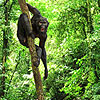 15. Pierolapithecus catalaunicus (popularly known as Pau); Late Miocene 13-11 Ma Spain - About 25 million years ago, Old World monkeys diverged from the primate line that led eventually to apes and humans. About 11 million to 16 million years ago, another branching occurred, when primates known as the great apes split from the lesser apes, represented by today's gibbons and siamangs. The discovery in 2004, Catalonia (Spain) of a 13 Mya fossil hominoid, Pierolapithecus catalaunicus, popularly known as Pau, has played a leading role in the research on the origin of the hominid family for almost a decade. Characteristics of its anatomy, suggests Pierolapithecus may have been bipdal therefor one of the earliest hominids ever known. Researchers Salvador Moya-Sola, et al at PIC locate Pierolapithecus as the common core of descending orangutans, gorillas, chimpanzees, bonobos and humans for understanding the elusive question of the Middle Miocene origin and early radiation of great apes. As many as 100 different ape species roamed the Miocene Old World, from France to China in Eurasia and from Kenya to Namibia in Africa but in Pau's time the Mediterranean Sea was even wider than it is today, so her ancestors must have taken a path through the Middle East and thence from Asia or Africa.
15. Pierolapithecus catalaunicus (popularly known as Pau); Late Miocene 13-11 Ma Spain - About 25 million years ago, Old World monkeys diverged from the primate line that led eventually to apes and humans. About 11 million to 16 million years ago, another branching occurred, when primates known as the great apes split from the lesser apes, represented by today's gibbons and siamangs. The discovery in 2004, Catalonia (Spain) of a 13 Mya fossil hominoid, Pierolapithecus catalaunicus, popularly known as Pau, has played a leading role in the research on the origin of the hominid family for almost a decade. Characteristics of its anatomy, suggests Pierolapithecus may have been bipdal therefor one of the earliest hominids ever known. Researchers Salvador Moya-Sola, et al at PIC locate Pierolapithecus as the common core of descending orangutans, gorillas, chimpanzees, bonobos and humans for understanding the elusive question of the Middle Miocene origin and early radiation of great apes. As many as 100 different ape species roamed the Miocene Old World, from France to China in Eurasia and from Kenya to Namibia in Africa but in Pau's time the Mediterranean Sea was even wider than it is today, so her ancestors must have taken a path through the Middle East and thence from Asia or Africa.
16. Equatorius africanus Middle Miocene 15.58 Ma-15.36 Ma Western Kenya - Middle Miocene Muruyur sediments near Kipsaramon in the Tugen Hills, Baringo District, Kenya. The specimen, representing much of the upper skeleton, comes from locality BPRP#122 dated between 15.58 Ma and 15.36 Ma. It is referable to the middle Miocene hominoid taxon Equatorius africanus. Preliminary descriptions of the partial skeleton are provided. While the anatomy of the wrist, thorax and hindlimb in Equatorius is similar to that of Afropithecus and Proconsul, the morphology of the n w skeleton confirms earlier interpretations of greater terrestriality in Equatorius.
17. Gigantopithecus blacki Late Miocene 11.9 Ma Western Kenya, Southern China, Vietnam, India & Pakistan - See also: How Gigantopithecus Became Extinct Smithsonian Magazine.
18. Dryopithecus laietanus Late Miocene 12-9.5 Ma France, Austria, Germany, Hungary & Spain - Dryopithecus is a genus mainly defined by isolated dental remains. All 4 species (D. brancoi, D. crusafonte, D. fontani, D. laietanus) display the following traits: robust incisors, compressed canines, elongated premolars and molars that were thinly enameled and robust jaws in males. The zygomatic bone of Dryopithecus displays characters (overall robusticity and 3 zygomaxillary foramina found on the frontal process that are functionally related to the presence of cheek pads.
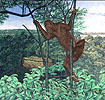 19. Sivapithecus Late Miocene 10-5-8 Ma Siwalkis of India and Pakistan - Sivapithecus includes a great diversity of Miocene ape species from South Asia. Fossils are known from between 10 and 7 million years ago, with many fossils recovered from the Siwalik region of Pakistan, but fossils assigned to Sivapithecus are found as far as China and Turkey. Sivapithecus represents the large radiation of the fossil Asian apes, and one or more forms are ancestral both to living orangutans as well as many fossil apes, including Lufengpithecus and Gigantopithecus. Based on plausibly assigned postcranial specimens, both S. indicus and S. sivalensis have estimated weights of 30-45 kg for males and 20-25 kg for females.
19. Sivapithecus Late Miocene 10-5-8 Ma Siwalkis of India and Pakistan - Sivapithecus includes a great diversity of Miocene ape species from South Asia. Fossils are known from between 10 and 7 million years ago, with many fossils recovered from the Siwalik region of Pakistan, but fossils assigned to Sivapithecus are found as far as China and Turkey. Sivapithecus represents the large radiation of the fossil Asian apes, and one or more forms are ancestral both to living orangutans as well as many fossil apes, including Lufengpithecus and Gigantopithecus. Based on plausibly assigned postcranial specimens, both S. indicus and S. sivalensis have estimated weights of 30-45 kg for males and 20-25 kg for females.
 20. Hispanopithecus laietanus
(appearance close to Dryopithecus) Late Miocene 9.5 Ma Catalonia, Spain - An ape nearly as large as a man (body mass 39-40 kg). Dryopithecus of Lartet, was closely allied to the anthropomorphous Hylobates, existed in Europe during the Late Miocene period. The postcranial (a hand) remains of the fossil great ape Hispanopithecus laietanus Villalta & Crusafont 1944 (Primates, Hominidae) from Can Llobateres (Late Miocene, MN10, about 9.5 Ma; Moyà-Solà & Köhler 1996; Köhler et al. 2001), formerly included within the genus Dryopithecus, allow us to test the hypothesis of whether suspensory adaptations are homologous between African great apes and orang-utans. Hispanopithecus, variously interpreted as an early pongine (Moyà-Solà & Köhler 1993, 1995; Köhler et al. 2001) or hominine (Begun et al. 1997), represents the first simultaneous evidence of an orthograde bodyplan combined with suspensory adaptations in the
hominoid fossil record. Dryopithecus/Hispanopithecus model in the Institut Català de Paleontologia Miquel Crusafont, in Sabadell, Catalonia
20. Hispanopithecus laietanus
(appearance close to Dryopithecus) Late Miocene 9.5 Ma Catalonia, Spain - An ape nearly as large as a man (body mass 39-40 kg). Dryopithecus of Lartet, was closely allied to the anthropomorphous Hylobates, existed in Europe during the Late Miocene period. The postcranial (a hand) remains of the fossil great ape Hispanopithecus laietanus Villalta & Crusafont 1944 (Primates, Hominidae) from Can Llobateres (Late Miocene, MN10, about 9.5 Ma; Moyà-Solà & Köhler 1996; Köhler et al. 2001), formerly included within the genus Dryopithecus, allow us to test the hypothesis of whether suspensory adaptations are homologous between African great apes and orang-utans. Hispanopithecus, variously interpreted as an early pongine (Moyà-Solà & Köhler 1993, 1995; Köhler et al. 2001) or hominine (Begun et al. 1997), represents the first simultaneous evidence of an orthograde bodyplan combined with suspensory adaptations in the
hominoid fossil record. Dryopithecus/Hispanopithecus model in the Institut Català de Paleontologia Miquel Crusafont, in Sabadell, Catalonia
 21. Nakalipithecus nakayamai Late Miocene 10 Ma Samburu, Kenya - The relative abundance of Eurasian apes between 12.5 and 8 Ma in contrast to a dearth of African apes during the same chronologic interval has led some investigators to suggest that the African ape/human clade evolved from a Eurasian ancestor, specifically, a previously undescribed and unnamed ape from Turkey. In the last several weeks, three new ape genera have been reported, one from Turkey (Ouranopithecus turkae), one from Ethiopia (Chororapithecus abyssinicus), and the latest, Nakalipithecus nakayamai, from Kenya. The apparent 14-7 Ma African "ape gap" is now populated not only by Nakalipithecus but also by the penecontemporaneous Kenyan large ape Samburupithecus kiptalami, dated slightly younger at 9.6 Ma, and by yet another large gorilla-like ape, C. abyssinicus, from the 10.5-10 Ma horizons of Chorora, Ethiopia. Additional isolated, but important, large ape remains from Ngorora, Kenya, localities believed to be ~12.5 Ma may evidence even greater species diversity. Did the African ape/human clade arise in Africa, after all? The apparent 14-7 Ma African "ape gap" is now populated not only by Nakalipithecus - described as a large ape, the size of a female gorilla, but also by the penecontemporaneous Kenyan large ape Samburupithecus kiptalami, dated slightly younger at 9.6 Ma, and by yet another large gorilla-like ape, C. abyssinicus, from the 10.5-10 Ma horizons of Chorora, Ethiopia. Additional isolated, but important, large ape remains from Ngorora, Kenya, localities believed to be ~12.5 Ma may evidence even greater species diversity. Did the African ape/human clade arise in Africa,
after all?
Cote (21) has demonstrated that the abundance of fossil ape remains in Eurasia, compared with a dearth of similar-aged apes in Africa is due to sampling: Eurasian localities are much richer and more diverse during this interval than African localities, and hence their apes are better represented. Africa has yielded the oldest and most diverse Miocene/Pliocene hominoids. It is the only continent where the chimp and gorilla live in the wild, and it has the earliest bona fide hominid sensu stricto remains. Moreover, there is no evidence of a mass ape extinction at the end of the Middle Miocene, nor is it likely that a Eurasian species founded the African ape/human clade as the result of a biogeographic retreat from Eurasia.
See also: Did Africa's Apes Come From Europe? Smithsonian Magazine.
21. Nakalipithecus nakayamai Late Miocene 10 Ma Samburu, Kenya - The relative abundance of Eurasian apes between 12.5 and 8 Ma in contrast to a dearth of African apes during the same chronologic interval has led some investigators to suggest that the African ape/human clade evolved from a Eurasian ancestor, specifically, a previously undescribed and unnamed ape from Turkey. In the last several weeks, three new ape genera have been reported, one from Turkey (Ouranopithecus turkae), one from Ethiopia (Chororapithecus abyssinicus), and the latest, Nakalipithecus nakayamai, from Kenya. The apparent 14-7 Ma African "ape gap" is now populated not only by Nakalipithecus but also by the penecontemporaneous Kenyan large ape Samburupithecus kiptalami, dated slightly younger at 9.6 Ma, and by yet another large gorilla-like ape, C. abyssinicus, from the 10.5-10 Ma horizons of Chorora, Ethiopia. Additional isolated, but important, large ape remains from Ngorora, Kenya, localities believed to be ~12.5 Ma may evidence even greater species diversity. Did the African ape/human clade arise in Africa, after all? The apparent 14-7 Ma African "ape gap" is now populated not only by Nakalipithecus - described as a large ape, the size of a female gorilla, but also by the penecontemporaneous Kenyan large ape Samburupithecus kiptalami, dated slightly younger at 9.6 Ma, and by yet another large gorilla-like ape, C. abyssinicus, from the 10.5-10 Ma horizons of Chorora, Ethiopia. Additional isolated, but important, large ape remains from Ngorora, Kenya, localities believed to be ~12.5 Ma may evidence even greater species diversity. Did the African ape/human clade arise in Africa,
after all?
Cote (21) has demonstrated that the abundance of fossil ape remains in Eurasia, compared with a dearth of similar-aged apes in Africa is due to sampling: Eurasian localities are much richer and more diverse during this interval than African localities, and hence their apes are better represented. Africa has yielded the oldest and most diverse Miocene/Pliocene hominoids. It is the only continent where the chimp and gorilla live in the wild, and it has the earliest bona fide hominid sensu stricto remains. Moreover, there is no evidence of a mass ape extinction at the end of the Middle Miocene, nor is it likely that a Eurasian species founded the African ape/human clade as the result of a biogeographic retreat from Eurasia.
See also: Did Africa's Apes Come From Europe? Smithsonian Magazine.
22. Chororapithecus abyssinicus Late Miocene 10 Ma Ethiopia - Chororapithecus abyssinicus was an ape that lived about 10 to 10.5 million years ago and is believed to be the earliest known species of gorilla. Its existence indicates that the last common ancestor between the human/chimpanzee lineage and gorillas may have lived greater than 10 to 11 million years ago, which is at least 2 million years earlier than the previously thought date of divergence of about 8 million years ago. Berhane Asfaw, at the Rift Valley Research Service in Ethiopia and co-author of the groundbreaking Chororapithecus study reported that molecular evidence indicates that it is likely that the mutations arose five times slower than previously thought, hence other common ancestors of great apes arose longer ago that it was previously known. The problem is made more difficult because there is scant evidence for the evolution of chimps and gorillas, according to Prof Peter Andrews at the Natural History Museum in London, UK.
23. Samburupithecus kiptalami Late Miocene 9.5 Ma Samburu Hills, Kenya - S. kiptalami was a large ape (60 kg) and was most likely a frugivorus terrestrial quadruped - Nakalipithecus less than 30 km (19 mi) from the Samburu area where another recently discovered ape, Samburupithecus, lived, shows that there were two different contemporary large hominids living in early late Miocene Kenya and if we include the contemporary Chororapithecus from nearby Ethiopia, known only from which may or may not be an ancestral gorilla, brings the tally to three hominines. The palaeoenvironment of the Namurungle Formation is important for the study of human evolution because of the presence of Samburupithecus kiptalami (Ishida & Pickford, 1997). Samburupithecus kiptalami is chronologically positioned between the Middle Miocene hominoids such as Kenyapithecus africanus, K. wickeri, Nacholapithecus kerioi and Equatorius africanus and the Latest Miocene hominids such as Orrorin tugenensis and Sahelanthropus tchadensis (e.g. Brunet et al., 2002; Ishida et al., 1999; Senut et al., 2001; Ward et al., 1999). Thus, S. kiptalami is likely to be close in age to the common lineage of the humans and African apes (Ishida & Pickford, 1997; Pickford & Ishida, 1997). Clarifying its palaeoenvironment greatly enriches our understanding of environmental context of the hominid-African ape divergence.
24. Graecopithecus Late Miocene 8-6.6 Ma Greece - Graecopithecus lived in northern and southern Greece about 9 mya, at roughly the same time as Samburupithecus in northern Kenya. Sahelanthropus inhabited Chad between 7 and 6 million years ago. Orrorin was from central Kenya 6 mya. Among these, the most likely ancestor of great apes and humans may be either Kenyapithecus or Griphopithecus. Among evolutionary models that stress the Eurasian species, some consider Graecopithecus to be ancestral only to the human lineage, containing Australopithecus, Paranthropus, and Homo, whereas others entertain the possibility that Graecopithecus is close to the great-ape ancestry of Pan (chimpanzees and bonobos) and Gorilla as well. In the former model, Dryopithecus is ancestral to Pan and Gorilla. On the other hand, others would have Dryopithecus ancestral to Pan and Australopithecus on the way to Homo, with Graecopithecus ancestral to Gorilla.
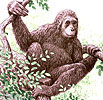 25. Ouranopithecus macedoniensis Late Miocene 9.0 Ma Northern Greece - O. macedoniensis was a large bodied ape, approximately the size of an adult female gorilla, with a large, broad face and a prominent supraorbital torus. It also had square-shaped orbits. The post cranial evidence is thin, but the dentition of O. macedoniensis suggests extreme sexual dimorphism, a far higher degree than that seen in any extant great ape. The ape was probably a quadruped. It is not possible to postulate on how O. macedoniensis used the trees but it seems likely that it did. Graecopithecus lived sometime between 8-6.6 Ma. Ouranopithecus, by contrast is considerably older, approximately 10-9 Ma. That means there is at least a one million year gap between these species, and at mo t a 3.4 Ma gap. See also: Phylogenetic Relationships of Ouranopithecus macedoniensis (Mammalia, Primates, Hominoidea, Hominidae) of the Late Miocene Deposits of Central Macedonia (Greece) Edited: by Louis de Bonis, et al.
25. Ouranopithecus macedoniensis Late Miocene 9.0 Ma Northern Greece - O. macedoniensis was a large bodied ape, approximately the size of an adult female gorilla, with a large, broad face and a prominent supraorbital torus. It also had square-shaped orbits. The post cranial evidence is thin, but the dentition of O. macedoniensis suggests extreme sexual dimorphism, a far higher degree than that seen in any extant great ape. The ape was probably a quadruped. It is not possible to postulate on how O. macedoniensis used the trees but it seems likely that it did. Graecopithecus lived sometime between 8-6.6 Ma. Ouranopithecus, by contrast is considerably older, approximately 10-9 Ma. That means there is at least a one million year gap between these species, and at mo t a 3.4 Ma gap. See also: Phylogenetic Relationships of Ouranopithecus macedoniensis (Mammalia, Primates, Hominoidea, Hominidae) of the Late Miocene Deposits of Central Macedonia (Greece) Edited: by Louis de Bonis, et al.
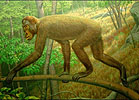 26. Khoratpithecus piriyai Late Miocene 9-6 Ma Thailand - (a new orang-utan relative) Sivapithecus, Ankarapithecus, and Lufengpithecus, are considered more distant relatives to the orangutan than Khoratpithecus. The Middle Miocene K. chiangmuanensis is older, displays more primitive dental characters, and shares several dental characters with the Late Miocene form. It is therefore interpreted as its probable ancestor. See more about how radiological techniques applied to teeth fossils enabled interpretation that distinguish species of the Khoratpithecus genus and determine which are more likely in continuous lineage to extant orangutans.
26. Khoratpithecus piriyai Late Miocene 9-6 Ma Thailand - (a new orang-utan relative) Sivapithecus, Ankarapithecus, and Lufengpithecus, are considered more distant relatives to the orangutan than Khoratpithecus. The Middle Miocene K. chiangmuanensis is older, displays more primitive dental characters, and shares several dental characters with the Late Miocene form. It is therefore interpreted as its probable ancestor. See more about how radiological techniques applied to teeth fossils enabled interpretation that distinguish species of the Khoratpithecus genus and determine which are more likely in continuous lineage to extant orangutans.
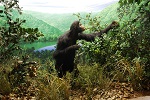 27. Oreopithecus bambolii Late Miocene 11-7 Ma Tuscany-Sardinia, Italy - O. bambolli was a large-bodied ape, estimated body mass 32 Kg, that survived a Late Miocene extinction event 9.6 Ma following the tectonic collision event of the Tusco-Sardinian provence with mainland Italy. By 6.5 Ma, the drying of the Tethys Sea created land bridges that may have allowed new predator species from Africa to invade its habit, although climatic events may have been as likely a factor for its eventual extinction at that time. Oreopithecus has been claimed to exhibit features that are adaptations to upright walking, such as the presence of a lumbar curve, in distinction to otherwise similar species known from the same period. Since the fossils have been dated to about 8 million years ago, this would represent an unusually early appearance of upright posture. However, a 2013 reevaluation of the spine from a skeleton of Oreopithecus led to a conclusion that it lacked adaptations for habitual bipedality. See also:Hominoid Evolution and Climatic Change in Europe: Volume 2: Phylogeny of the Neogene Hominoid Primates of Eurasia 1st Edition by Louis de Bonis - What is the place of Europe in the origin of humankind? Our earliest human ancestors may have come out of Africa, but many of our more recent ancestors have been found in Europe and the Near East. This volume examines these Eurasian fossils and discusses what we can learn from them.
27. Oreopithecus bambolii Late Miocene 11-7 Ma Tuscany-Sardinia, Italy - O. bambolli was a large-bodied ape, estimated body mass 32 Kg, that survived a Late Miocene extinction event 9.6 Ma following the tectonic collision event of the Tusco-Sardinian provence with mainland Italy. By 6.5 Ma, the drying of the Tethys Sea created land bridges that may have allowed new predator species from Africa to invade its habit, although climatic events may have been as likely a factor for its eventual extinction at that time. Oreopithecus has been claimed to exhibit features that are adaptations to upright walking, such as the presence of a lumbar curve, in distinction to otherwise similar species known from the same period. Since the fossils have been dated to about 8 million years ago, this would represent an unusually early appearance of upright posture. However, a 2013 reevaluation of the spine from a skeleton of Oreopithecus led to a conclusion that it lacked adaptations for habitual bipedality. See also:Hominoid Evolution and Climatic Change in Europe: Volume 2: Phylogeny of the Neogene Hominoid Primates of Eurasia 1st Edition by Louis de Bonis - What is the place of Europe in the origin of humankind? Our earliest human ancestors may have come out of Africa, but many of our more recent ancestors have been found in Europe and the Near East. This volume examines these Eurasian fossils and discusses what we can learn from them.
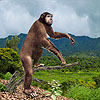 28. Sahelanthropus tchadensis Late Miocene 7-6 Ma Chad, Afica - S. tchadensis body size estimates range between male orangutan and female gorilla and was likely bipedal. It is a candidate as the earliest species to have made the evolutionary transition from hominoid to hominid and even possibly to be in the direct ancestral lineage of our Homo taxa. Some of the oldest evidence of a humanlike species moving about in an upright position comes from Sahelanthropus. The foramen magnum (the large opening where the spinal cord exits out of the cranium from the brain) is located further forward (on the underside of the cranium) than in apes or any other primate except humans. This feature indicates that the head of Sahelanthropus was held on an upright body, probably associated with walking on two legs. Unfortunately, most of Sahelanthropus’ teeth are heavily worn, and there have not yet been studies of its tooth wear or tooth isotopes to indicate diet. However, we can infer based on its forest environment and other early human species that it ate a mainly plant-based diet. This probably included leaves, fruit, seeds, roots, nuts, and insects.
28. Sahelanthropus tchadensis Late Miocene 7-6 Ma Chad, Afica - S. tchadensis body size estimates range between male orangutan and female gorilla and was likely bipedal. It is a candidate as the earliest species to have made the evolutionary transition from hominoid to hominid and even possibly to be in the direct ancestral lineage of our Homo taxa. Some of the oldest evidence of a humanlike species moving about in an upright position comes from Sahelanthropus. The foramen magnum (the large opening where the spinal cord exits out of the cranium from the brain) is located further forward (on the underside of the cranium) than in apes or any other primate except humans. This feature indicates that the head of Sahelanthropus was held on an upright body, probably associated with walking on two legs. Unfortunately, most of Sahelanthropus’ teeth are heavily worn, and there have not yet been studies of its tooth wear or tooth isotopes to indicate diet. However, we can infer based on its forest environment and other early human species that it ate a mainly plant-based diet. This probably included leaves, fruit, seeds, roots, nuts, and insects.
See also Youtube Video Search for the First Human - Sahelanthropus Tchadensis. Paleoanthropologist featured in the video is author of book From Hominoid Arboreality to Hominid Bipedalism (EBook pp. 77-98) by Brigitte Senut. Abstract: During the 2000s, several new taxa of putative hominids have been described from the Upper Miocene of Africa: Orrorin tugenensis from the Tugen Hills, Kenya (6.1 to 5.7 Ma), Ardipithecus kadabba from the Middle Awash, Ethiopia (5.7 to 5.2 Ma) and Sahelanthropus tchadensis from Toros-Menalla, Chad (7 to 6 Ma). Bipedal locomotion has been claimed for all these taxa, but only Orrorin exhibits clear features of bipedalism. One drawback to the study of human origins is that scholars usually tend to compare the fossils only with modern apes (usually chimpanzees) and with modern humans; the modern apes often erroneously being considered as primitive and humans as derived. Miocene apes possess a higher diversity of locomotor repertoires than modern ones and it appears reductionist to focus only on modern hominoids to understand how bipedalism emerged. It is crucial to take into consideration the locomotion of Miocene apes knowing that even if these hominoids could occasionally walk bipedally, their bones did not exhibit the morphology of later bipedal hominids. Miocene large hominoids were arboreal animals adapted to climbing. The locomotor repertoire of early hominids was a mixture of bipedal locomotion and climbing, as indicated by the morphology of the limbs of Orrorin and Australopithecus. The study of locomotion must be carried out in an environmental context. When we consider the Miocene apes, it appears that they inhabited forest (dry or humid) or wooded environments; arboreal life was a survival strategy, for feeding and escaping from predators. Palaeontological and depositional data from the Lukeino Formation, Kenya, indicate that Late Miocene hominids lived in forested environments. Despite the usual belief, prevalent since Darwin, that humans and thus bipedalism emerged in a savanna environment, it appears that the emergence of hominids took place in a closed habitat and that bipedalism might have had its origins in an arboreal way of life. See more: References to Hominid Phylogeny, Dispersal and Bipedality
 29.
Orrorin tugenensis Late Miocene 6 Ma Kenya, Africa - In 2001, a research team led by French paleontologist Brigitte Senut and French geologist Martin Pickford discovered this species in the Tugen Hills region of central Kenya. They found more than a dozen early human fossils dating between about 6.2 million and 6.0 million years old. Because of its novel combination of ape and human traits, the researchers gave a new genus and species name to these fossils, Orrorin tugenensis, which in the local language means - original man in the Tugen region. So far, Orrorin tugenensis is the only species in the genus Orrorin. Orrorin’s femur (thigh bone) and humerus (upper arm bone) are about 1.5 times larger than those of Lucy’s (AL 288-1) showing evidence of bone buildup typical of a biped - so Orrorin tugenensis individuals climbed trees but also probably walked upright with two legs on the ground. Scientists estimate that Orrorin would have been 1.5 times larger than Australopithecus afarensis, suggesting a size similar to a female chimpanzee, between about 30 and 50 kg. If Orrorin proves to be a direct human ancestor, then australopithecines such as Lucy may be considered a side branch of the hominid family tree: Orrorin is both earlier, by almost 3 million years, and more similar to modern humans than is A. afarensis. The main similarity is that the Orrorin femur is morphologically closer to that of H. sapiens than is Lucy's and had small teeth with thick enamel, similar to modern humans. There is, however, as with many phylogenic scenarios, considerable debate over these speculations.
29.
Orrorin tugenensis Late Miocene 6 Ma Kenya, Africa - In 2001, a research team led by French paleontologist Brigitte Senut and French geologist Martin Pickford discovered this species in the Tugen Hills region of central Kenya. They found more than a dozen early human fossils dating between about 6.2 million and 6.0 million years old. Because of its novel combination of ape and human traits, the researchers gave a new genus and species name to these fossils, Orrorin tugenensis, which in the local language means - original man in the Tugen region. So far, Orrorin tugenensis is the only species in the genus Orrorin. Orrorin’s femur (thigh bone) and humerus (upper arm bone) are about 1.5 times larger than those of Lucy’s (AL 288-1) showing evidence of bone buildup typical of a biped - so Orrorin tugenensis individuals climbed trees but also probably walked upright with two legs on the ground. Scientists estimate that Orrorin would have been 1.5 times larger than Australopithecus afarensis, suggesting a size similar to a female chimpanzee, between about 30 and 50 kg. If Orrorin proves to be a direct human ancestor, then australopithecines such as Lucy may be considered a side branch of the hominid family tree: Orrorin is both earlier, by almost 3 million years, and more similar to modern humans than is A. afarensis. The main similarity is that the Orrorin femur is morphologically closer to that of H. sapiens than is Lucy's and had small teeth with thick enamel, similar to modern humans. There is, however, as with many phylogenic scenarios, considerable debate over these speculations.
Further Reading About Miocene, Hominoid Apes and African/Eurasian Paleogeography
Accommodating phylogenetic uncertainty in evolutionary studies Huelsenbeck JP, et al Abstract; Many evolutionary studies use comparisons across species to detect evidence of natural selection and to examine the rate of character evolution. Statistical analyses in these studies are usually performed by means of a species phylogeny to accommodate the effects of shared evolutionary history. The phylogeny is usually treated as known without error; this assumption is problematic because inferred phylogenies are subject to both stochastic and systematic errors. Morphological and Paleobiogeographical Evidence for the Dispersal of Hominines Into Africa in the Late Miocene.
Recent Progress in Paleontological Methods for Dating the Tree of Life by Michel Laurin, 2012. Dating the Tree of Life (TOL) has become a major goal of biological research. Beyond the intrinsic interest of reconstructing the history of taxonomic diversification, time-calibrated trees (timetrees for short, as used throughout below) are required in many types of comparative analyses, where branch lengths are used to assess the conservation importance of lineages, correlation between characters, or to assess phylogenetic niche conservatism, among other uses. There is no universally accepted species concept, despite repeated attempts to unify species concepts (e.g., de Queiroz, 1998). As such, the entities that we call "species" and that are registered into various databases are not ontologically comparable; some are clades, some are reproductive communities, some are evolutionary lineages, others are phenetic clusters, and yet others belong to two or more of these categories.
Bayesian Interference Bayesian inference of phylogeny uses a likelihood function to create a quantity called the posterior probability of trees using a model of evolution, based on some prior probabilities, producing the most likely phylogenetic tree for the given data. The Bayesian approach has become popular due to advances in computing speeds and the integration of Markov chain Monte Carlo (MCMC) algorithms. Bayesian inference has a number of applications in molecular phylogenetics and systematics.
Credibility of the hypotheses Which method is the best? This is the most common question when students o scholars for the first time have been exposed to the dizzying array of methods available (of which just a fraction has been treated here) to infer a phylogenetic tree. Alas, there is no answer to that question. Firstly, we need to define what we mean by "best" since there are some mutually incompatible demands we have on a method, and secondly it appears that the performance of the different methods vary with the data at hand.
 Miocene Apes by David R. Begun,1995 - One Interpretation of Relations among Fossil and Living Hominoids Instead of arranging taxa in an evolutionary tree, most researchers today prefer dendrograms such as this one, which arrange taxa based on relations but avoid speculations about ancestors and descendants. Note, for example, that Proconsul is not ancestral to other forms; it simply branched off first. The common ancestor of Proconsul and other hominoids is represented by node A, which is not a named taxon but a hypothetical ancestral form sharing characteristics of both Proconsul and other hominoids. In this phylogeny, Sivapithecus, Lufengpithecus, and Pongo share a common ancestor at C not shared by any other taxon. They are thus most closely related to one another, and related in the same way to all other taxa, with which they are linked at B. Similarly, Dryopithecus shares a common ancestor with Ouranopithecus at E, and both share an ancestor with the African apes and humans at D. Humans (including Australopithecus) share a common ancestor with chimps (Pan) at F, and are therefore more closely related to chimps than either are to gorillas. See Table 1 - Fossil Hominoid Taxa and Chronology: Taxa are listed opposite their localities. First occurrences are listed in their entirety; subsequent occurrences are abbreviated. Localities within a row are contemporaneous if separated by a comma or placed in relative stratigraphic position if separated by a period. This table illustrates the incredible diversity of Miocene hominoid taxa. Many remain unnamed (Hominoidea indet.), but when these are combined with named taxa approximately thirty genera of hominoid can be identified. Given that this probably represents a small percentage of the total number of forms that actually existed (known fossils greatly underrepresent taxonomic diversity in the past) and considering the fact that only five genera of hominoid exist today, the Miocene can truly be considered the golden age of apes.
Miocene Apes by David R. Begun,1995 - One Interpretation of Relations among Fossil and Living Hominoids Instead of arranging taxa in an evolutionary tree, most researchers today prefer dendrograms such as this one, which arrange taxa based on relations but avoid speculations about ancestors and descendants. Note, for example, that Proconsul is not ancestral to other forms; it simply branched off first. The common ancestor of Proconsul and other hominoids is represented by node A, which is not a named taxon but a hypothetical ancestral form sharing characteristics of both Proconsul and other hominoids. In this phylogeny, Sivapithecus, Lufengpithecus, and Pongo share a common ancestor at C not shared by any other taxon. They are thus most closely related to one another, and related in the same way to all other taxa, with which they are linked at B. Similarly, Dryopithecus shares a common ancestor with Ouranopithecus at E, and both share an ancestor with the African apes and humans at D. Humans (including Australopithecus) share a common ancestor with chimps (Pan) at F, and are therefore more closely related to chimps than either are to gorillas. See Table 1 - Fossil Hominoid Taxa and Chronology: Taxa are listed opposite their localities. First occurrences are listed in their entirety; subsequent occurrences are abbreviated. Localities within a row are contemporaneous if separated by a comma or placed in relative stratigraphic position if separated by a period. This table illustrates the incredible diversity of Miocene hominoid taxa. Many remain unnamed (Hominoidea indet.), but when these are combined with named taxa approximately thirty genera of hominoid can be identified. Given that this probably represents a small percentage of the total number of forms that actually existed (known fossils greatly underrepresent taxonomic diversity in the past) and considering the fact that only five genera of hominoid exist today, the Miocene can truly be considered the golden age of apes.
European Miocene Hominids and the Origin of the African Ape and Human Clade by David R. Begun, Mariam C. Nargolwalla and László Kordos 3 FEB 2012 See also: Miocene Hominids and the Origins of the African Apes and Humans by David R. Begun June 14, 2010
See also: European Miocene hominids and the origin of the African ape and human clade by David R. Begun, 2012 download
Human Prehistory by Christopher Seddon Out of Africa - and back again: Proconsul comprised 3-5 species, ranging in size from 11 kg (roughly the size of a gibbon) to 87 kg (orang-utan sized). Kenyapithecus africanus, a hominoid that appeared around 16-15 mya, is often touted as the direct ancestor of the great apes and humans. Its more immediate descendents could have included a number of later Eurasian Miocene hominoids: Ouranopithecus, Sivapithecus and Gigantopithecus. By this time, beginning 17-18 Ma hominoids were migrating across the newly-established land bridge into Eurasia where they flourished. At least seven genera probably existed: Dryopithecus (14-8 mya, known from central and western Europe), Pliopithecus (16-11 mya, known western and south-central Europe and southern China), Ouranopithecus a.k.a. Graecopithecus (9.6-8.7 mya, known from Greece), Sivapithecus (12.5-7 mya, known from Siwalik Hills on India-Pakistan border and in Turkey), Gigantopithecus (6.3-0.5 mya, Siwalik, western China, Vietnam [largest primate ever, bigger than a gorilla]), Lufengpithecus (8-7 mya, known from Lufen in southern China) and Oreopithecus (9-8 mya, known from Italy). The poor hominoid fossil record in Africa after 13 mya has led some to propose scenarios in which hominoids left Africa, but their descendants later returned. One possible scenario is that the ancestor of all of the above (possibly Kenyapithecus) dispersed out of Africa and gave rise (via one of the genera described above) to the gibbons and great apes in Eurasia. One group later moved back to Africa and begat the gorillas, chimps, and humans. This move back to Africa would have happened after the gibbon/great ape divergence, but before the emergence of Sivapithecus. This "Out of Africa and back again" scenario seems highly plausible.
Synchrotron Light Illuminates the Orang-utan's Obscure Origins by Paul Tafforeau from the University of Poitiers and the European Synchrotron Radiation Facility in Grenoble, France, 2007 - (Analysis of Khoratpithecus fossils) Together, the high levels of diversity and the wide geographic distribution in geological strata of Asian hominoids (from 16.5 MY ago to the present) strongly suggest that Asia was an important, perhaps even the principal, centre of diversification for Miocene hominoids. Increasingly, therefore, modern palaeological research is lending weight to the newer hypothesis of hominoid evolution: our hominoid ancestors originated in Africa, after which they diversified in Asia and repopulated Africa and Europe.
Late Miocene Hominoids: Back to the Future by blogger DAE - Raising questions about Chinese hominoid fossils, consensus phylogy and cherished notions regarding what distinguishes hominin and hominoid. 2010 blog: The discovery of a 7 million year old hominoid tooth in Bulgaria may not sound like much but it could be a "big deal." For one, it demonstrates that late Miocene (Turolian) apes persisted in Europe much later than previously thought. The Turkish ape, Ouranopithecus turkae, with a biochronological age of 8.7-7.4 mya and fossil hominoids from Yunnan attributed to Lufengpithecus, dated between 6-11 mya, also last well into the Turolian. It is also during the Turolian that purported basal hominans (i.e. Sahelanthropus) begin to appear in the African fossil record. Geneticists have long argued for a late divergence of chimpanzees and humans between 4-6 mya. Human paleontologists, however, have recently wanted to push this divergence further back in time to accommodate the likes of Sahelanthropus. The increasingly dense and diagnostic late Miocene hominoid fossil record may thus force us to either acknowledge an early divergence hypothesis for hominan origins or accept the fact that stem hominines (i.e. the ancestors of the extant African apes and humans) were indistinguishable from early hominans. The poster child for this latter hypothesis may be Ardipithecus. Hypothesis 3: Late Miocene Eurasian apes, with features that have been favorably compared with hominans, are either early pongines or stem hominoids that evolved adaptations for bipedalism and other hominan-like traits in parallel with our African ancestors, suggesting that features that have long been thought to distinguish the human lineage from other hominoids are not so unique after all.
Evolution of the second orangutan: phylogeny and biogeography of hominid origins John R. Grehan and Jeffrey H. Schwartz Abstract - Aim: To resolve the phylogeny of humans and their fossil relatives (collectively,hominids), orangutans (Pongo) and various Miocene great apes and to present a biogeographical model for their differentiation in space and time. Location: Africa, northern Mediterranean, Asia. Methods: Maximum parsimony analysis was used to assess phylogenetic relationships among living large-bodied hominoids (= humans, chimpanzees,bonobos, gorillas, orangutans), and various related African, Asian and European ape fossils. Biogeographical characteristics were analysed for vicariant replacement, main massings and nodes. A geomorphological correlation was identi?ed for a clade we refer to as the 'dental hominoids', and this correlation was used to reconstruct their historical geography. Uploaded by Jeffrey Schwartz - 22 pages
Ponginae Ponginae is a subfamily of the Homindae family, the family that encompases all the great apes, living and extinct. Today there are only two living species of the Ponginae subfamily, those being the aforementioned Orangutans. During the Miocene there were, however, more members of this subfamily. Some of them are contenders for the ancestor of the modern Orangutan, while others are often considered to be sister clades. These include: Lufengpithecus, Sivapithecus, Ankarapithecus, Khoratpithecus and Gigantopithecus. These apes will be the primary subjects of discussion in the following installments of Asian Miocene Apes. There are also a few genera whose placement within the Ponginae subfamily remains an issue of debate. These include: Griphopithecus, and Ouranopithecus. Neither of these species have been found within Asia, however, some researchers have argued for a connection between these apes and those found in Asia. There is also the matter of Dryopithecus. To the best of my knowledge no one considers Dryopithecus to be a member of the Ponginae subfamily. There are, however, some researchers which do argue that some species Dryopithecus did inhabit parts of Asia. Although this view has largely fallen out of favor in recent years it is probably still a good idea to explore it a little bit. These apes of contention (Griphopithecus, Ouranopithecus, and Dryopithecus) will be discussed towards the end of this series
Primate Volcano Deaths Proconsul suffered somewhat during Africa's collision with Eurasia. Volcanic activity eached a peak 18 million years ago, especially in East Africa. The Kisingiri volcano erupted, apparently with a pyroclastic flow, killing whole populations of Proconsul which lived in an environment that was semi-arid, covered mostly in dry, deciduous, single-canopy woodland, with some evergreen forest in restricted, low-lying areas. Kisingiri-Rangwa volcano is located in western Kenya, on the shore of Lake Victoria, 80 km SW of Kisumu. Despite repeated volcanic activity around this period, the species persisted into the Middle Miocene (15 to 10 million years) when it overlapped with Kenyapithecus. Another early hominoid also existed in Africa around 20 million years ago. Ugandapithecus major is known to have lived around the site of a now-extinct volcano in Uganda's remote north-east Karamoja region. Scientists say preliminary analysis of a single specimen discovered there showed that the tree-climbing herbivore was roughly ten years old when it died. The skull was about the same size as that of a chimp, but its brain was smaller.
Hominoigea Extinction In Europe After an initial radiation in Africa 23 million years ago, hominids began to disperse in Eurasia by 14 million years ago where they diversified leading to numerous species. The greatest example of this diversity is found in the Catalan fields del Valles-Penedes, which since the mid-twentieth century have provided new species of this group as pierolapithecus (the hominoid found in Els Hostalets de Pierola and described by the specimen popularly known as Pau), anoiapithecus (the only representative of which is nicknamed Lluc) or Hispanopithecus laietanus 9 Mya (sic: billion years) and often represented by the specimen called Jordi.
Updated chronology for the Miocene hominoid radiation in Western Eurasia by Isaac Casanovas-Vilara et al Dec 10, 2010 - Abstract: Extant apes (Primates: Hominoidea) are the relics of a group that was much more diverse in the past. They originated in Africa around the Oligocene/Miocene boundary, but by the beginning of the Middle Miocene they expanded their range into Eurasia, where they experienced a far-reaching evolutionary radiation. A Eurasian origin of the great ape and human clade (Hominidae) has been favored by several authors, but the assessment of this hypothesis has been hampered by the lack of accurate datings for many Western Eurasian hominoids. Here we provide an updated chronology that incorporates recently discovered Iberian taxa and further reevaluates the age of many previously known sites on the basis of local biostratigraphic scales and magnetostratigraphic data. Our results show that identifiable Eurasian kenyapithecins (Griphopithecus and Kenyapithecus) are much younger than previously thought (ca. 14 Mya instead of 16 Mya), which casts serious doubts on the attribution of the hominoid tooth from Engelswies (16.3-16.5 Mya) to cf. Griphopithecus. This evidence is further consistent with an alternative scenario, according to which the Eurasian pongines and African hominines might have independently evolved in their respective continents from similar kenyapithecin ancestors, resulting from an early Middle Miocene intercontinental range extension followed by vicariance.
Family Proconsulidae - includes all Early Miocene apes. It includes the species Dendropithecus, Dionysopithecus (found in Asia), Limnopithecus (whose denticia was similar to that of Proconsul), Micropithecus, and Rangwapithecus. Micropithecus is the smallest known ape (living or fossil) and its face is similar to modern gibbons (Fleagle, 1978). Proconsul and Afropithecus were probably arboreal apes. The modified han s of Nacholapithecus kerioi indicate that it adapted for climbing and was more arboreal than other Miocene apes. Kenyapithecus was more adapted to terrestrial locomotion than other Miocene apes (Nakatsukasa, 2003).
Early Primates Primate fossils are common from the Miocene. However, not all primates are equally represented in the fossil record. Apes apparently evolved from monkeys early in this epoch. Fossil monkeys and prosimians are comparatively rare from most of the Miocene, but apes are common. It appears that apes at that time occupied some ecological niches that would later be filled by monkeys. One of the earliest of the monkey to ape transitional primates was Proconsul. It lived in African forests 21-14 million years ago. Among the numerous Miocene primate species were the ancestors of all modern apes and humans. By 14 million years ago, the group of apes that included our ancestors was apparently in the process of adapting to life on the edges of the expanding savannas in Southern Europe. They were very likely members of the genus Dryopithecus which were generally similar in appearance to modern African apes. These apes evolved mostly during a relatively short global heat wave that began around 15 million years ago. This caused enough polar ice to melt so that sea levels once again rose 80-130 feet. Toward the end of the Miocene, less hospitable cooler conditions in the northern hemisphere once again caused many primate species to become extinct while some survived by migrating south into Africa and South Asia where it remained relatively warm. About 8-9 million years ago, the descendants of the dryopithecines in Africa diverged into two lines--one that led to gorillas and another to humans, chimpanzees, and bonobos. Around 7 million years ago, a further divergence occurred which separated the ancestors of modern chimpanzees and bonobos from the early hominins (human-like primates) that were our direct ancestors. (See time chart summarizing primate evolution over the last 60 million years.)
Middle Miocene Dispersals of Apes by Andrews P, Kelley J. - Department of Palaeontology, Natural History Museum, London, UK. Abstract: The 2 best known species of fossil ape are known from the site of Pasalar in Turkey. They have almost identical molar and jaw morphology. Molar morphology is also similar to that of specimens from Germany and Slovakia, but there are significant differences in the anterior teeth of the 2 Pasalar species. The more common species, Griphopithecus alpani, shares mainly primitive characters with early and middle Miocene apes in Africa, and it is most similar phenetically to Equatorius africanus from Maboko Island and Kipsaramon. The second species is assigned to a new species of Kenyapithecus, an African genus from Fort Ternan in Kenya, on the basis of a number of shared derived characters of the anterior dentition, and it is considered likely that there is a phylogenetic link between them. The African sites all date from the middle Miocene, similar in age to the Turkish and European ones, and the earliest emigration of apes from Africa coincides with the closure of the Tethys Sea preceding the Langhian transgression.
Morphometric Affinities of Gigantopithecus by Gelvin BR Am J Phys Anthropol. 1980 Nov - Abstract: Gigantopithecus displays affinities to Ouranopithecus and to the hominids, particularly the Plio-Plelstocene hominids, rather than to the apes. It is rather important that Ouranopithecus, Lufengopithecus, and their allies are all generally thought to have some tendency to moving bipedally on the ground (suspected for Sahelanthropus and more definitely for Ardipithecus).
The Biology of the Colonizing Ape by Wells JC, Stock JT. Am J Phys Anthropol, 2007 Abstract: Hominin evolutionary history is characterized by regular dispersals, cycles of colonization, and entry into novel environments. This article considers the relationship between such colonizing capacity and hominin biology...We propose that early hominin adaptive radiations were based upon the development of such capacities as adaptations to unstable Pliocene environments. These components came together, along with fundamental changes in morphology, behavior, and cognition in the genus Homo, who exploited them in subsequent wider dispersals. Middle Pleistocene hominins and modern humans also show development of further traits, which correspond with successful probing of, and dispersals into, stressful environments. These traits have their precursors in primate or ape biology, but have become more pronounced during hominin evolution. First, short interbirth intervals and slow childhood growth allow human females to provision several offspring simultaneously, increasing the rate of reproduction in favorable conditions. This allows rapid recovery from population crashes, or rapid population growth in new habitats. Second, despite high geographical phenotypic variability, humans have high genetic unity. This is achieved by a variety of levels of plasticity, including physiology, behavior, and technology, which reduce the need to commit to genetic adaptation. Hominin behavior may increasingly have shaped both the ecological niches occupied and the selective pressures acting back on the genome. Such selective pressures may have been exacerbated by population dynamics, predicted to both derive from, and favor, the colonizing strategy. Exposure to ecological variability is likely to have generated particular selective pressures on female biology, favoring increasing steering of offspring ontogeny by maternal phenotype. We propose that the concept of hominins as "colonizing apes" offers a novel unified model for interpreting the suite of traits characteristic of our genus.
Orrorin tugenensis Living around 6 million years ago, Orrorin tugenensis is the one of the oldest early humans on our family tree. Individuals of this species were approximately the size of a chimpanzee and had small teeth with thick enamel, similar to modern humans. The most important fossil of this species is an upper femur, showing evidence of bone buildup typical of a biped - so Orrorin tugenensis individuals climbed trees but also probably walked upright with two legs on the ground.
Hominin Origins 206 Chapter 9 - Miocene Fossil Hominoids During the approximately 18 million years of the Miocene (23-5 mya), a great deal of evolutionary activity took place. In Africa, Asia, and Europe, a diverse and highly successful group of hominoids emerged. Indeed, there were many more forms of hominoids from the Miocene than are found today (now represented by the highly restricted groups of apes and one species of humans). In fact, the Miocene could be called "the golden age of hominoids". Many thousands of fossils have been found from dozens of sites scattered in East Africa, southern Africa, southwest Asia, into western and southern Europe, and extending into southern Asia and China. The single most important defining characteristic for the full course of hominin evolution is bipedal locomotion. In the earliest stages of hominin emergence, skeletal evidence indicating bipedal locomotion is the only truly reliable indicator that these fossils were indeed hominins. But in later stages of hominin evolution, other features, especially those relating to brain development and behavior, become highly significant.
Over the last three decades, the Miocene hominoid assemblage has been interpreted and reinterpreted. As more fossils are found, the evolutionary picture grows more complicated. The vast array of fossil forms has not yet been completely studied, so conclusions remain tenuous. Given this uncertainty, it's probably best, for the present, to group Miocene hominoids geographically: (A detail presentation follows.)
Bipedal Adaptations In the Hominid Pelvis by Paul Wren, 2006 - Convergent Bipedal Adaptation - Is hominid bipedalism such an unlikely adaptation that it is unique, or could it develop independently under other conditions? A significant amount of fossil remains have been found for Oreopithecus bambolii, a Miocene hominoid from the Tuscany region. Its pelvis differs from its contemporaries such as Dryopithecus, and multiple features may be linked with bipedality (Kohler and Moya-Sola, 1997). Specifically, the Oreopithecus pelvis shows a hominid-like anterior inferior iliac spine; a pubis closely resembling A. afarensis, and its ischial spine is almost identical to that of Homo. Oreopithecus specimens also show a lordosis, a trait heretofore considered unique to hominids (ibid.). Kohler and Moya-Sola (1997) propose that Oreopithecus may represent convergent evolution of bipedal traits. This is certainly a possibility since Oreopithecus was isolated on the island of Tuscany-Sardinia during the Miocene, an environment void of predators. They suggest that while not a habitual biped, Oreopithecus may have adapted to standing erect for the purpose of feeding, returning to a quadrupedal mode for locomotion.
Review of Oreopithecus bambolii 15-page download
Acquisition of bipedalism: Acquisition of bipedalism: the Miocene hominoid record and modern analogues for bipedal protohominids by Masato Nakatsukasa, May, 2004 Abstract: Unfortunately, after 13 Ma, there is a gap in the hominoid postcranial record in Africa until 6 Ma. Due to this gap, a scenario for later locomotor evolution prior to the divergence of Homo and Pan cannot be determined with certainty. The time gap also causes difficulties when we seek to determine polarities of morphological traits in very early hominids. Interpretation of the form-function relationships of postcranial features in incipient hominids will be difficult because it is predicted that they had incorporated bipedalism only moderately into their total positional repertoires. However, Japanese macaques, which are trained in traditional bipedal performance, may provide useful hints about bipedal adaptation in the protohominids. Kinematic analyses revealed that these macaques walked bipedally with a longer stride and lower stride frequency than used by ordinary macaques, owing to a more extended posture of the hindlimb joints.
Abrboreal Beginnings 20-10 Ma During the Early and Middle Miocene eras, dating from 20 to 10 million years ago, Africa had a much higher annual rainfall level than today. A single super- rainforest covered most of the continent from shore to shore. A hominoid (primate) ancestor common to all living apes and humans lived in the trees of this super- rainforest. Africa first became connected to Eurasia around 18 million years ago, causing major geological upheavals, and transforming formerly flat landscapes by pushing up some of the world's youngest mountain ranges: the Pyrenees, the Alps, and the Zagros mountains, as well as the mountains and rift valleys of East Africa. Geographical transformations were accompanied by gradual climatic and environmenta changes which may even have triggered the emergence of the first specialised hominoids. The very earliest known representatives of the hominoids have been found only in Africa and were very different from living apes and humans. The oldest finds belong to a group of species in the genus Proconsul. Fossils of Proconsul have been found in Early Miocene deposits 22 million years old in Kenya, and along the rift valley, although it probably originated rather earlier, between 25 and 28 million years ago.
Family Proconsulidae includes all Early Miocene apes A detail presentation of references specific to species in the Proconsulidea.
[sic]Hominid Dispersal: ca 15-14.5 Million years ago, dispersal of the Proconsuls and early apes Out Of Africa. early apes are most similar to macaque monkeys in size and appearance but they already have the standard types of molar teeth that apes and humans still have. hominid dispersal2: 13 to 14 Million years ago approximately. Dryopithecine radiation. Sivapithecine apes make a first appearance in the Siliwak deposits of India 9 to 10.5-9 Ma. This would represent Ouranopithecus' age except that it persisted longer than the indicated date. The majority of apelike creatures are dying out in Europe and the Near East, becoming established in tropical Asia and Africa instead.
Extended Topics Beyond Miocene Hominoid
Ape/Hominid Phylogeny, Dispersal and Bipedality
Is It Time to Revise the System of Scientific Naming? Lee R. Berger for National Geographic News December 4, 2001
What do we know about early hominin relationships? Weblog by John Hawks 29 Mar 2014 - What I found is that many of the small samples in the hominin fossil record are not good enough to test hypotheses about their phylogeny. With the addition of each new taxon, the number of possible hominid phylogenies grows exponentially greater, and with this number grows the number of ways that phylogenies may be in error.
A map of some evolution concepts that along with similarly complex maps of concept parameters in each field of
paleogeography, paleoclimatology and paleoanthropology are subject to their combined errors in interpreting fossil evidence.
See also more ways for errors: Big Bang Concept Map
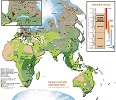 Hominini Clade The Hominini is a tribe of the subfamily Homininae; it comprises three subtribes: Hominina, with its one genus Homo; Australopithecina, comprising several extinct genera (see taxobox); and Panina, with its one genus Pan, the chimpanzees (see the evolutionary tree). Members of the human clade, that is, the Hominini, including Homo and those species of the australopithecines that arose after the split from the chimpanzees, are called hominins. See also: Hominidae
Hominini Clade The Hominini is a tribe of the subfamily Homininae; it comprises three subtribes: Hominina, with its one genus Homo; Australopithecina, comprising several extinct genera (see taxobox); and Panina, with its one genus Pan, the chimpanzees (see the evolutionary tree). Members of the human clade, that is, the Hominini, including Homo and those species of the australopithecines that arose after the split from the chimpanzees, are called hominins. See also: Hominidae
Our Ancestors: Hominids and Hominins - Important conventions? Hominids: Members of the lineage that includes genus Homo (humans) and genus Pan (chimpanzees) but not other apes. Hominins: Members of the lineage of humans ("human branch") following split (divergence) of genus Homo with genus Pan from their Last Common Ancestor (LCA) about 5 million years ago. Grade is a category based on the outcome of the evolutionary history rather than on the process of the evolutionary history. Taxa in the same grade are adapted to eat same sort of foods, share the same posture and mode of locomotion. Categorization into grades is somewhat subjective and debatable especially when evidence is sparse. According to Wood B. and Lonergan in review "The hominin fossil record: taxa, grades and clades", J. Anat. (2008) extant hominids and hominins can be tentatively divided into the following grades: Possible and probable hominins, Archaic hominins, Megadont archaic hominins, Pre-modern Homo and Anatomically modern Homo. Different species, often geographically separated and presumably not closely related, can be attributed to a same grade. The chart below shows that many species and grades of hominins co-exist d with each other. Humans share a lot of features with other vertebrates, other mammals, and, of course, other apes. Presented here is a collection of features that in modern scientific literature are considered more or less unique to humans among all other animals or, sometimes, more specifically, among other primates. Pease note a difference between qualitative (truly unique) and quantitative (presented in varied degrees) characteristics. Absense of baculum (os penis). Os penis, an isolated bone located above the distal end of the urethra in the penis of many mammals; it is present in most primates, carnivores, and rodents; humans differ from all Old World monkeys and apes in complete absense of the penile bone. The os penis serves to assure rapid erectile state in absence of developed erectile tissues. Comparative study of primates showed that baculum length is broadly correlated with breeding system. Briefly, the more sperm competition is expected the bigger the baculum. The smallest baculum is usually found in pair-forming primates. In some animals, os penis is a point of vulnerability, for example, when male otters fight, they try to seize and break external genitalia of their adversary. Can we explain absence of baculum in Homo sapiens by evolution of bipedality and upright posture? In our ancestors, who just started to walk on two hind legs, most coveted body parts, like belly and external reproductive organs, became suddenly exposed. The vulnerability of penis in bipedal locomotion and decreased sperm competition under conditions of monogamous relashionships could've applied selective pressures in favor of occurrence of genitalia less prominent at rest but greatly expandable on demand.
Evolution of Walking Upright In more recent decades, anthropologists have determined that bipedalism has very ancient roots. In 2001, a group of French paleoanthropologists unearthed the seven-million-year-old Sahelanthropus tchadensis in Chad. Known only from a skull and teeth, Sahelanthropus' status as an upright walker is based solely on the placement of its foramen magnum, and many anthropologists remain skeptical about the species' form of locomotion.
African Genesis - Perspectives on Hominin Evolution Edited by Sally C. Reynolds Edited by Andrew Gallagher, Cambridge Studies in Biological and Evolutionary Anthropology, 2012
The Miocene Hominoids and the Earliest Putative Hominids
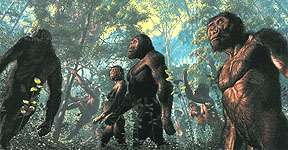 From hominoid arboreality to hominid bipedalism pp. 77-98 EBook by Brigitte Senut Abstract: The idea of an ascendance for our species is quite recent (about 150 years ago). But questions remain: who was this ancestor, and where and when did he arise? In the 1980s, early hominids were known only from southern and eastern Africa. Digging in Djurab desert (Northern Chad) from 1994 onwards, the Mission Paleoanthropologique Franco-Tchadienne (MPFT) team unearthed first a new australopithecine (dated to 3.5 Ma, Brunet et al., 1995; Lebatard et al., 2008), the first ever found west of the Rift Valley and a later new hominid Sahelanthropus tchadensis (Brunet et al., 2002a) from the late Miocene, dated to 7 Ma (Vignaud et al., 2002; Lebatard et al., 2008). This earliest known hominid is a new milestone suggesting that an exclusively southern or eastern African origin of the hominid clade is likely to be incorrect. In the last decade our roots have descended deeper into the Lower Pliocene (4.4 Ma) to the Late Miocene (7 Ma) with three new species: Ardipithecus kadabba (5.8-5.2 Ma, Middle Awash, Ethiopia), Orrorin tugenensis (c. 6 Ma, Lukeino, Kenya) and the oldest one Sahelanthropus tchadensis (c. 7 Ma). S. tchadensis displays a unique combination of derived characters that clearly shows hominid affinities that are close, temporally speaking, to the last common ancestor between chimpanzees and humans, and that it cannot be related to chimpanzees or gorillas. In Chad, the Late Miocene sedimentological and palaeobiological data indicate the presence of a mosaic environment probably very similar to the present Okavango Delta (Central Kalahari, Bostwana). As with the other Late Miocene hominids, S. tchadensis was a bipedal animal living in a wooded habitat. It is now clear that the earliest hominids did not inhabit savannah environments, nor were they living only in South and East Africa. In the light of this new evidence, our early hominid history must now be reconsidered within a completely new paradigm.
From hominoid arboreality to hominid bipedalism pp. 77-98 EBook by Brigitte Senut Abstract: The idea of an ascendance for our species is quite recent (about 150 years ago). But questions remain: who was this ancestor, and where and when did he arise? In the 1980s, early hominids were known only from southern and eastern Africa. Digging in Djurab desert (Northern Chad) from 1994 onwards, the Mission Paleoanthropologique Franco-Tchadienne (MPFT) team unearthed first a new australopithecine (dated to 3.5 Ma, Brunet et al., 1995; Lebatard et al., 2008), the first ever found west of the Rift Valley and a later new hominid Sahelanthropus tchadensis (Brunet et al., 2002a) from the late Miocene, dated to 7 Ma (Vignaud et al., 2002; Lebatard et al., 2008). This earliest known hominid is a new milestone suggesting that an exclusively southern or eastern African origin of the hominid clade is likely to be incorrect. In the last decade our roots have descended deeper into the Lower Pliocene (4.4 Ma) to the Late Miocene (7 Ma) with three new species: Ardipithecus kadabba (5.8-5.2 Ma, Middle Awash, Ethiopia), Orrorin tugenensis (c. 6 Ma, Lukeino, Kenya) and the oldest one Sahelanthropus tchadensis (c. 7 Ma). S. tchadensis displays a unique combination of derived characters that clearly shows hominid affinities that are close, temporally speaking, to the last common ancestor between chimpanzees and humans, and that it cannot be related to chimpanzees or gorillas. In Chad, the Late Miocene sedimentological and palaeobiological data indicate the presence of a mosaic environment probably very similar to the present Okavango Delta (Central Kalahari, Bostwana). As with the other Late Miocene hominids, S. tchadensis was a bipedal animal living in a wooded habitat. It is now clear that the earliest hominids did not inhabit savannah environments, nor were they living only in South and East Africa. In the light of this new evidence, our early hominid history must now be reconsidered within a completely new paradigm.
Orrorin and the African Ape/Hominid Dichotomy pp. 99-119 EBook by Martin Pickford Abstract: Prior to the year 2000, the dominant paradigms of hominid origins could be summarised as follows: (a) the African ape/human (AAH) dichotomy occurred about 5 Ma, perhaps 6 Ma for some authors, or as young as 2.5 Ma for others; (b) the precursors of hominids were probably quadrupedal, terrestrial apes; (c) the AAH transition likely took place in the savannah; (d) the last common ancestor (LCA) of African apes and humans looked like a chimpanzee (prolonged face, enlarged canines in males, knuckle-walking locomotion and black body coats); and (e) there was an australopithecine stage between the LCA and the genus Homo. The discovery of the 6 million-year-old bipedal hominid Orrorin in the Lukeino Formation, Kenya, in 2000, and in particular its femora, which showed that it was fully bipedal, was bound to pose serious challenges to all these paradigms. Given that Orrorin is almost twice as old as Lucy, Australopithecus antiquus, which is possibly a species different from Australopithecus afarensis in which it is usually classified) (Ferguson, 1984) and almost 2 million years older than Ardipithecus ramidus, it would be surprising if it didn't upset the apple cart to some extent. Further studies in the Lukeino Formation reveal that most previous ideas concerning remote hominid origins need to be modified or refined. Not only their biological aspects, but also their chronological and environmental aspects require rethinking.
Hominin Origins Mural by Viktor Deak
Possible Primitive Members of Bipedal Hominin by Kack R. Holt - Most of the bipedal hominin radiation occurred during the Pliocene (5.3-2.5 mya) and Pleistocene (2.5-0.012 mya) epochs. The end of the Miocene was relatively warm, but at the end of a gradual cooling trend. The trend continued through the Pliocene and into the Pleistocene, when the amplitudes of the climatic swings became very great during a time of extremely unsettled and variable climatic shifts. The last 1.5 million years was especially unsettled with glacial advances and relatively warm interglacial periods. The earliest grade of bipedal ape, the possible hominin grade, was represented by Sahelanthropus (~7 Ma) (about the size of a female gorilla - weight 70 - 140 kg (150 - 310 lb) and Ardipithecus (6.0-4.2 Ma) from eastern Africa. These possible hominins are important in that their fossil remains have been dated near the separation of the human-chimp line. Sahelanthropus was found in Chad, very far from the Rift Valley and South Africa where almost all other early hominin remains had been found and around the time when the Sahara Desert had just begun to form (Schuster et al. 2006). Its presence in central Africa suggests that the hominins may have ranged much more widely on the African continent (Brunet et al. 2002). Brunet (2012) describes Sahelanthropus, which is known only from features of the skull, as having a suite of primitive and derived characters that make it unlikely to be a precursor to the chimpanzee line. Also, it lived in a mosaic of woodland and open spaces, a landscape more like that of the bipedal hominins. Thus, the postcranial skeleton likely will be somewhat similar to that of Ardipithecus. Postcranial remains of Ardipithecus ramidus are known for females only - roughly the size of a female gorilla. They were bipedal but had a foot with a divergent toe (Haile-Selassie et al. 2012). The interpretation was that they must have been arboreal, at least part of the time. Indeed, their remains were found in association with plants that occur in forests. The upper body had the proportions of a chimpanzee and the range of movement in the shoulder that suggested aa animal well adapted to climbing and swinging in the trees. This seemed to support the theory that bipedalism did not evolve in animals adapted to life in the savannahs, but rather by animals that brachiated and walked on limbs very much like orangutans do. If so, bipedal stance evolved in the trees well before our line began to walk on the ground. Aside from bipedality, Ardipithecus resembled chimpanzees. The brain case was about 300-350 cc in volume (females) and they weighed about 50 kg. Also, females were approximately 120 cm tall.
Morphometric affinities of Gigantopithecus Am J Phys Anthropol, 1980 BR Gelvin. Abstract: Multivariate analyses, supplemented by univariate statistical methods, of measurements from mandibular tooth crown dimensions and the mandible of Gigantopithecus blacki, G. bilaspurensis, Plio-Plelstocene hominids, Homo erectus, and seven Neogene ape species from the genera Proconsul, Sivapithecus, Ouranopithecus, and Dryopithecus were used to assess the morphometric affinities of Gigantopithecus. [End of Abstract excerpt] It is rather important that Ouranopithecus, Lufengopithecus, and their allies are all generally thought to have some tendency to moving bipedally on the ground (suspected for Sahelanthropus and more definitely for Ardipithecus). From the Wikipedia entry on Gigantopithecus: "Gigantopithecus's method of locomotion is uncertain, as no pelvic or leg bones have been found. The dominant view is that it walked on all fours like modern gorillas and chimpanzees; however, a minority opinion favor bipedal locomotion, most notably championed by the late Grover Krantz, but this assumption is based only on the very few jawbone remains found, all of which are U-shaped and widen towards the rear. This allows room for the windpipe to be within the jaw, allowing the skull to sit squarely upon a fully erect spine like modern humans, rather than roughly in front of it, like the other great apes." (then commonly used in reference to the other similar Miocene apes that were otherwise suspected of showing bipedal adaptations or at least a habitual asumption of an upright stance)
Early Primate Radiation
 Rapid Asia-Europe-North America geographic dispersal of earliest Eocene primate Teilhardina during the Paleocene-Eocene Thermal Maximum Thierry Smith, et al, 2005 Abstract: True primates appeared suddenly on all three northern continents during the 100,000-yr-duration Paleocene-Eocene Thermal Maximum at the beginning of the Eocene, 55.5 mya. The simultaneous or nearly simultaneous appearance of euprimates on northern continents has been difficult to understand because the source area, immediate ancestors, and dispersal routes were all unknown. Now, omomyid haplorhine Teilhardina is known on al three continents in association with the carbon isotope excursion marking the Paleocene-Eocene Thermal Maximum. Relative position within the carbon isotope excursion indicates that Asian Teilhardina asiatica is oldest, European Teilhardina belgica is younger, and North American Teilhardina brandti and Teilhardina americana are, successively, youngest. Analysis of morphological characteristics of all four species supports an Asian origin and a westward Asia-to-Europe-to-North America dispersal for Teilhardina. High-resolution isotope stratigraphy indicates that this dispersal happened in an interval of 25,000 yr. Rapid geographic dispersal and morphological character evolution in Teilhardina reported here are consistent with rates observed in other contexts.
Rapid Asia-Europe-North America geographic dispersal of earliest Eocene primate Teilhardina during the Paleocene-Eocene Thermal Maximum Thierry Smith, et al, 2005 Abstract: True primates appeared suddenly on all three northern continents during the 100,000-yr-duration Paleocene-Eocene Thermal Maximum at the beginning of the Eocene, 55.5 mya. The simultaneous or nearly simultaneous appearance of euprimates on northern continents has been difficult to understand because the source area, immediate ancestors, and dispersal routes were all unknown. Now, omomyid haplorhine Teilhardina is known on al three continents in association with the carbon isotope excursion marking the Paleocene-Eocene Thermal Maximum. Relative position within the carbon isotope excursion indicates that Asian Teilhardina asiatica is oldest, European Teilhardina belgica is younger, and North American Teilhardina brandti and Teilhardina americana are, successively, youngest. Analysis of morphological characteristics of all four species supports an Asian origin and a westward Asia-to-Europe-to-North America dispersal for Teilhardina. High-resolution isotope stratigraphy indicates that this dispersal happened in an interval of 25,000 yr. Rapid geographic dispersal and morphological character evolution in Teilhardina reported here are consistent with rates observed in other contexts.
Late Middle Eocene Primate (Radiation) from Myanmar and the initial anthropoid colonization of Africa by Yaowalak Chaimanee, et al, 2012 Abstract: Reconstructing the origin and early evolutionary history of anthropoid primates (monkeys, apes, and humans) is a current focus of paleoprimatology. Although earlier hypotheses frequently supported an African origin for anthropoids, recent discoveries of older and phylogenetically more basal fossils in China and Myanmar indicate that the group originated in Asia. Given the Oligocene-Recent history of African anthropoids, the colonization of Africa by early anthropoids hailing from Asia was a decisive event in primate evolution. However, the fossil record has so far failed to constrain the nature and timing of this pivotal event. Here we describe a fossil primate from the late middle Eocene Pondaung Formation of Myanmar, Afrasia
that is remarkably similar to, yet dentally more primitive than, the roughly contemporaneous North African anthropoid Afrotarsius. Phylogenetic analysis suggests that Afrasia 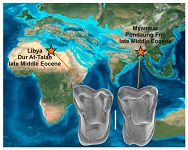 and Afrotarsius are sister taxa within a basal anthropoid clade designated as the infraorder Eosimiiformes. Current knowledge of eosimiiform relationships and their distribution through space and time suggests that members of this clade dispersed from Asia to Africa sometime during the middle Eocene, shortly before their first appearance in the African fossil record. Crown anthropoids and their nearest fossil relatives do not appear to be specially related to Afrotarsius, suggesting one or more additional episodes of dispersal from Asia to Africa. Hystricognathous rodents, anthracotheres, and possibly other Asian mammal groups seem to have colonized Africa at roughly the same time or shortly after anthropoids gained their first toehold there. source study summary and map (middle eocene map with fossil teeth superimposed in Myamar and Libya)
and Afrotarsius are sister taxa within a basal anthropoid clade designated as the infraorder Eosimiiformes. Current knowledge of eosimiiform relationships and their distribution through space and time suggests that members of this clade dispersed from Asia to Africa sometime during the middle Eocene, shortly before their first appearance in the African fossil record. Crown anthropoids and their nearest fossil relatives do not appear to be specially related to Afrotarsius, suggesting one or more additional episodes of dispersal from Asia to Africa. Hystricognathous rodents, anthracotheres, and possibly other Asian mammal groups seem to have colonized Africa at roughly the same time or shortly after anthropoids gained their first toehold there. source study summary and map (middle eocene map with fossil teeth superimposed in Myamar and Libya)
Miocene and Plio-Pleistocene Mammal Dispersal
Miocene Mammal Disperal The Miocene was a long-lasting epoch in which the earth's climate rebounded from the cooling of the Oligocene and there was a marked increase in both global temperatures and the total number of mammal species. Though warmer than the Oligocene, the polar ice caps remained in place. India collided with Asia, causing a massive upthrust of the Asian continent that created the Tibetan plateau and the Himalayas. As Africa moved northwards to link with Europe, the Tethys Sea, a vast seaway that once existed between the two continents Europe and Africa, disappeared. As the Miocene progressed, the earth began to cool once more; the climate became more arid and mammalian diversity began to decrease again. Grasslands underwent a major expansion in the early Miocene and mammalian herbivores, including equids, rhinos, and many artiodactyls, had to evolve a variety of new adaptation to cope with the more open and arid habitats and coarser vegetation. It is not uncommon to find many species of horses coexisting in the Miocene. In addition to horses, the Miocene mammal faunas of North American were dominated by rhinos, such as Teleoceras, a large variety of camels, extinct relatives of elephants called gomphotheres, "bone-crushing" borophagine dogs, and cat-like saber-toothed predators known as nimravids. There are many more fossils from the Miocene than for previous time periods and Miocene fossils are known from a greater number of geographic regions; for example, Miocene fossils are abundant in Africa, while there are very earlier fossils from that continent. The drop in sea levels during the Miocene associated with the growth of polar ice caps led to the first exposure of what is now Florida in the Miocene, and an extensive fossil record of horses and other Miocene mammals is preserved there. Miocene fossil mammals are found across a wide range of localities in the USA, including California, Nebraska, and Texas.
Pliocene and Pleistocene The Pliocene and Pleistocene epochs are commonly combined and referred to as the Plio-Pleistocene because of their short duration in comparison to previous epochs, and also because the events that took place during these epochs are very closely associated. The Pliocene spans the interval 5.3 - 2.6 MYA and the Pleistocene 2.6-0.01 MYA. Two very important events of the Pliocene are the formation of Arctic ice sheets, heralding the beginning of the ice age, and the emergence of a land bridge between South America and North America, ending the 60-million-year isolation of South America. This allowed some unique South American mammals- such as armadillos, glyptodonts, and giant ground sloths- to migrate into North America, and many more North American species; including horses, tapirs, saber toothed cats, mammoths, peccaries, and deer; to enter South America. There were widespread extinctions of endemic South American mammals.
Miocene Paleogeography
The geological dynamics underway in the Late Oligicene and during the entire Miocene played a crucial role in the story of hominoid radiation and are as fraught with uncertanties as the effort in paleobiology to ascertain which species may be in the lineage of our human ancestry. Where and when the the African and Eurasian land masses converged that began hominoid dispersal (and later return) range in spacetime margins of error of 65 million years and locality options from Iberia to Arabia.
Arabia-Eurasia Collision Retrodeforming the Arabia-Eurasia collision zone: Age of collision versus magnitude of continental subduction, 2013 - Nadine McQuarrie1 and Douwe J.J. van Hinsbergen - When did continents collide, and how is convergence partitioned after collision, are first order questions that seem to defy consensus. Estimates for the age of the ArabiaEurasia collision have ranged from the Late Cretaceous to Pliocene, most authors prefer a collision age between 35-20 Ma.
Some Conflicting Timelines
Map - Tethys sea 16 Ma The role of eastern Tethys seaway closure in the Middle Miocene Climatic Transition (ca. 14 Ma) N. Hamon, et al Abstract. The Middle Miocene Climatic Transition (MMCT, approximately 14 Ma) is a key period in Cenozoic cooling and cryospheric expansion. Despite being well documented in isotopic record, the causes of the MMCT are still a matter of debate. Among various hypotheses, some authors suggested that it was due the final closure of the eastern Tethys seaway and subsequent oceanic circulation reorganisation. However, we cannot provide any information on the initial collision between Afro-Arabia and Eurasia, and further work is needed to bring new constraints on this event.
Messinian Salinity Crisis When the Messinian Salinity Crisis was at its Maximum in late Miocene, the Mediterranean was reduced to several separate salt lakes similar to the Dead Sea with surface levels several hundred meters below the World Ocean's surface level. If we imagine that the Strait of Gibraltar, the Suez Canal and the Dardanelles was closed; the Mediterranean would dry out in only 1,000 years leaving a 70 m. thick layer of salt and gypsum on the bottom. In 1970 the marine survey ship Glomar Challenger found thick layers of evaporation products in the seabed on a water depth of 3 km. It is said that in some places has been found layers of evaporation products, mostly salt and gypsum, which are 2-3 kilometers thick. If one desiccation of the Mediterranean will create a salt layer at 70 m. then about 30-40 consecutive cycles of flooding and drying out are needed in order to create a layer of salt and gypsum of 2-3 kilometers. This shows that the Mediterranean has been dried out and filled again - not once but several times.
Paratethys-Mediterranean Interactions Environmental Crises during the Neogene Marius Stoica, Mihaela C. Melinte-Dobrinescu & Dan Palcu (eds.) Mediterranean Neogene Straigraphy (selected work)
Tethys Sea Map 16 Ma This map shows the Tethys sea 16 million years ago, in the Middle Miocene era, some 2 million years after a series of movements in the Earth's crust had connected Africa and Eurasia for the first time. This landbridge allowed African animals, including apes and monkeys, to cross into Europe and Asia, while some rodents and cats moved in the opposite direction.
Miocene 23 Ma referencing same map:
Miocene 20 Ma World of the Miocene 20 million. years before present - Note that the Indian subcontinent is fully in place and seriously is pushing against the Eurasian plate thereby creating the Tibetan Plateau. The Drake Passage is open and there are still connection between the Atlantic and Pacific through the Panama Strait between North and South America. The Tethys Sea is now fully closed and reduced to a series of inland seas. Between 17 and 14.5 million years before present, a new temperature maximum occurred called "Mid-Miocene Climatic Optimum"
Mediterranean Paleo Geography The Mediterranean Sea has, for the most part, been open in some form or another since the Triassic (or so - at least, according to the mainstream interpretation. For example, here is a reconstruction of the Region during the Rupellian (33.9 - 28.4 MYA). Basically, during the Triassic the Mediterranean was open to the west, rather than the east, but as Africa continued its motion, that ocean (called the Tethys) was closed, however, as the Atlantic ocean opened, the region was opened to the ocean to the east as well as the west. By the mid miocene the Mediterranean had been squeezed so that it was long and narrow map, and seperated completely from the para-tethys (which gave us the Caspian sea). The closing continued, and still continues. 6 million years ago there was a series of basin wide salinity crises, by 5.6 million years ago the basin was finally isolated from the atlantic. Between 5.6 and 5.5 million years ago there was extensive erosion as rivers emptying into the mediterranean carved canyons comparable to the grand canyon, and between 5.5 and 5.3 million years ago, the basin was largely dessicated.
Early and Middle Miocene During the Early and Middle Miocene eras, dating from 20 to 10 million years ago, Africa had a much higher annual rainfall level than today. A single super-rainforest covered most of the continent from shore to shore. A hominoid (primate) ancestor common to all living apes and humans lived in the trees of this super-rainforest. Africa first became connected to Eurasia around 18 million years ago, causing major geological upheavals, and transforming formerly flat landscapes by pushing up some of the world's youngest mountain ranges: the Pyrenees, the Alps, and the Zagros mountains, as well as the mountains and rift valleys of East Africa. Geographical transformations were accompanied by gradual climatic and environmental changes which may even have triggered the emergence of the first specialised hominoids. The very earliest known representatives of the hominoids have been found only in Africa and were very different from living apes and humans. The oldest finds belong to a group of species in the genus Proconsul. Fossils of Proconsul have been found in Early Miocene deposits 22 million years old in Kenya, and along the rift valley, although it probably originated rather earlier, between 25 and 28 million years ago.
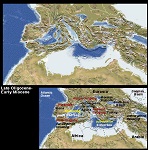 Mediterranean Paleo Geography The Mediterranean Sea has, for the most part, been open in some form or another since the Triassic (or so - at least, according to the mainstream interpretation. For example, here is a reconstruction of the Region during the Chattian (28.4 - 23 Ma). Basically, during the Triassic the Mediterranean was open to the west, rather than the east, but as Africa continued its motion, that ocean (called the Tethys) was closed, however, as the Atlantic ocean opened, the region was opened to the ocean to the east as well as the west. By the mid miocene the Mediterranean had been squeezed so that it was long and narrow map, and seperated completely from the para-tethys (which gave us the Caspian sea). The closing continued, and still continues. 6 million years ago there was a series of basin wide salinity crises, by 5.6 million years ago the basin was finally isolated from the atlantic. Between 5.6 and 5.5 million years ago there was extensive erosion as rivers emptying into the mediterranean carved canyons comparable to the grand canyon, and between 5.5 and 5.3 million years ago, the basin was largely dessicated.
Mediterranean Paleo Geography The Mediterranean Sea has, for the most part, been open in some form or another since the Triassic (or so - at least, according to the mainstream interpretation. For example, here is a reconstruction of the Region during the Chattian (28.4 - 23 Ma). Basically, during the Triassic the Mediterranean was open to the west, rather than the east, but as Africa continued its motion, that ocean (called the Tethys) was closed, however, as the Atlantic ocean opened, the region was opened to the ocean to the east as well as the west. By the mid miocene the Mediterranean had been squeezed so that it was long and narrow map, and seperated completely from the para-tethys (which gave us the Caspian sea). The closing continued, and still continues. 6 million years ago there was a series of basin wide salinity crises, by 5.6 million years ago the basin was finally isolated from the atlantic. Between 5.6 and 5.5 million years ago there was extensive erosion as rivers emptying into the mediterranean carved canyons comparable to the grand canyon, and between 5.5 and 5.3 million years ago, the basin was largely dessicated.
Paratethys Sea During its long existence the Paratethys was at times reconnected with the Tethys or its successors, the Mediterranean Sea or Indian Ocean. From the Pliocene epoch onward (after 5 million years ago), the Paratethys became progressively shallower. Today's Black Sea, Caspian Sea, Aral Sea and Lake Urmia are remnants of the Paratethys Sea.
The Proto-Tethys Ocean was an ancient ocean that existed from the latest Ediacaran to the Carboniferous (550-330 Ma). It was an ocean predecessor of the later Paleo-Tethys Ocean.
Tethys Ocean First phase of the Tethys Ocean's forming: the (first) Tethys Sea starts dividing Pangaea into two supercontinents, Laurasia and Gondwana.
The Paratethys Paratethys sea or just Paratethys was a large shallow sea that stretched from the region north of the Alps over Central Europe to the Aral Sea in Central Asia.
Look up Tethys name for the sea that anciently lay between Eurasia and Africa-Arabia, coined 1893 by German geologist Eduard Suess (1831-1914), from Tethys, name of a Greek sea goddess, sister and consort of Oceanus.
Miocene Tectonics and Paleoclimate During the Miocene, Eurasia underwent some significant tectonic rearrangements. The Tethys Sea connection between the Mediterranean and Indian Ocean was severed in the mid-Miocene causing an increase in aridity in southern Europe (see next paragraph for more on this). The Paratethys barrier, which isolated western Europe from the exchange of flora and fauna, was periodically disrupted, allowing for the migration of animals. Additionally, faunal routes with Africa were well established and occasional land bridges were created. Africa also encountered some tectonic movement, including rifting in East Africa and the union of the African-Arabian plate with Eurasia. Associated with this rifting, a major uplift in East Africa created a rain shadow effect between the wet Central-West Africa and dry East Africa. The union of the continents of Africa and Eurasia caused interruption and contraction of the Tethys Sea, thereby depleting the primary source of atmospheric moisture in that area. Thus rainfall was signific ntly reduced, as were the moderating effects of sea temperature on the neighboring land climates. However, this union enabled more vigorous exchanges of flora and fauna between Africa and Eurasia.
Italy Miocene During the Messinian (7Ma) all the endemic species of the Tusco-sardinian bioprovince disappeared and were replaced by a continental fauna with clear European affinities (BONFIGLIO 2005). This geological period is marked by a pronounced sea level drop of the Mediterranean Sea, causing deposition of thousand of meters thick evaporites. The former isolated islands get reconnected with the European continent, and a dramatic faunal turnover occurred. Only on still isolated islands some species characteristic for the Abruzzi-Apulia bioprovince survived this dramatic episode until the Pliocene, but with the establishment of the tectonic raised land bridge from the promontory of Gargano to the Italian peninsula, the last Hoplitomeryx went extinct. See more
Maltese Paleo Geography The Alpine folds were a result of the swinging together of the African and European plates (Continental Drift Theory), pushing up mountains. The fourth episode resulted in the submarine elevation dividing the Mediterranean Sea into two basins. About 6.5 million years ago, closure of the Gibraltar Straits resulting in a drying up of the Mediterranean which resulted in a land-bridge between Malta and Europe, possibly connecting also Africa. This state of affairs continued throughout the Pliocene period, when large rivers or tributaries flowed over the Islands' area. The evidence of these is the large number of water-ways, like Wied il-Kbir and Wied il-Ghasel, which have left their mark on the Islands. At about 5 million years ago tectonic activity resulted in a re-opening of the Gibraltar Straits filling up the Mediterranean and isolating the Maltese Islands area from the mainland. It is not known whether the Islands were directly connected with Africa. The French paleontologist Vaufrey holds that the Pleistocene fossils found in Malta are typical of those in Europe, while typical African fossils have not been found. On the other hand J. Borg holds that the flora typical to Malta is of African origin and is only found in the southern regions of Europe. On palaegeographical basis it is probable that the Islands were connected to Africa, but separation from the African continent occurred long before that with the European mainland. About 2 million years ago, the world climate underwent a series of cold-warm periods which gave rise to the Ice Ages. These climatic fluctuations caused the periodic growth of ice sheets on land in high latitudes and mountains during the glacial periods, while the interglacial climate was similar to those prevailing today. The ice cap during the glacial periods advanced at a rate of about 100m/yr and has been estimated to have been about 2500 meters thick across Europe. The ice cap however never reached further than 40o latitude and thus the Maltese Islands were never covered with ice. The uptake of water by the increasing European ice-caps resulted in a total drop in the sea level, estimated at a total drop of 150 m in the Central Mediterranean during the last Ice Age. This sea level drop is sufficient to expose the submarine ridge of the Central Mediterranean thus connecting the Maltese islands to mainland Europe. It is estimated that the Pleistocene may hav undergone a total of about 17 cold periods. This cycle of mainland connection of the Maltese Islands followed by a period of isolation allowed for the development of a number of endemic species which were generally characterised by dwarfism of the herbivore and carnivore mammals, and gigantism of the rodents, reptilian and aviuan species. Similar species development has also been reported from other Mediterranean Islands. The Pleistocene and Holocene, till recently, saw the Islands covered by forests which were destroyed by early man.
Some particularly contradictory data about how and when Africa connected with Eurasia.
Source below says: 20 MYA Africa connects with Europe closing Tethys Sea while in west open to Indian Ocean. Then says: 10 MYA plate collisions sealed off eastern Tethys. Then says 6 MYA Spain and Africa Collide raising mountain barrier sealing off the Tethys.
But next 3 sources say:
1. 14 MYA eastern Tethys seaway closure in the Middle Miocene Climatic Transition and
2. Tortonian stage (~7-11 Myr ago) of the Late Miocene epoch as the pivotal period for triggering north African aridity and creating the Sahara desert. and
3. 25 MYA towards the end of the Oligocene and the beginning of the Miocene, to the east, the collision process between the Iberian and European plates had finished. The Pyrenees, the Catalan Coastal Range and the Iberian Range already had the same fold structure as they present day. The old Gulf of Tethys had been practically disconnected from the rest of the ocean and an interior sea had been formed, the Paleomediterranean (Tethys). 7 MYA the Messinian "crisis" the Mediterranean basin and the emerged land that surrounded it dried up. The major part of the area was converted into a gigantic salt flat situated at hundreds of metres below the level of the Atlantic.
Closure of the Tethys by Steven Dutch, Natural and Applied Sciences, University of Wisconsin - Green Bay
Fig 1: The Mediterranean region 20 million years ago. Present coastlines are shown for reference only. Deep water is deep blue and shallow seas are light blue. The exact configuration of pieces making up Greece and Turkey are unknown. This portion of the Tethys is about to close as Africa and Eurasia converge. However, there would have been no need of a Suez Canal, and Columbus would not have needed to sail west to try to reach China.
Fig 2: By 10 million years ago, plate collisions hav sealed off the eastern Mediterranean, trapping small remnants of ocean floor in the Black and Caspian Seas. Mountain barriers in the Balkans seal of a large inland sea, which becomes brackish as salt water is flushed out by river water.
Fig 3: By 6 million years ago, Spain and Africa collide, raising a mountain barrier and sealing off the western end of the Mediterranean. River inflow is not enough to maintain the level of the Mediterranean, which dries out. However, rivers flowing to the Mediterranean can cut below Atlantic sea level. Eventually one does, and Atlantic sea water starts flowing in, cutting the Strait of Gibraltar and filling the Mediterranean.
Source 1. tethys_closer_mid_miocene.jpg Middle Miocene Climatic Transition The role of eastern Tethys seaway closure in the Middle Miocene Climatic Transition (ca. 14 Ma) N. Hamon1, et al Introduction: The Miocene was a period of major climatic and oceanographic changes (Zachos et al., 2001). In particular, the Middle Miocene Climatic Transition (MMCT), approximately 14.2 to 13.8 Ma, was a major step in the Cenozoic global cooling and Antarctic ice-sheet expansion (Zachos et al., 2001; Billups and Schrag, 2002; Shevenell et al., 2004)
Source 2. Tortonian Aridity Tortonian stage (~7-11 Myr ago) of the Late Miocene epoch as the pivotal period for triggering north African aridity and creating the Sahara desert. Through a set of experiments with the Norwegian Earth System Model10 and the Community Atmosphere Model11, we demonstrate that the African summer monsoon was drastically weakened by the Tethys Sea shrinkage during the Tortonian.
Source 3. The opening of the western Mediterranean. The upper Oligocene and the Miocene - Towards the end of the Oligocene and the beginning of the Miocene, some 25 Ma ago, the collision process between the Iberian and European plates had finished. The Pyrenees, the Catalan Coastal Range and the Iberian Range already had the same fold structure as they present day. The sediments that formed the alluvial fans, which had been deposited at the foot of the mountain fronts of the Pyrenees, were now folded forming spectacular progressive unconformities. The Ebro Basin maintained an endorheic regimen with the eastern area, or Central Catalan Basin, totally filled and occupied by an extensive alluvial plain which drained towards the west, where the lacustrine conditions are maintained. To the east, the old Gulf of Tethys had been practically disconnected from the rest of the ocean and an interior sea had been formed, the Paleomediterranean (figure 13).
EVOLUTION-INVOLUTION SLIDESHOW
MAYA-GAIA INTRODUCTION & SITEMAP
Anthropic Trilogy Web-Books

